Target Information
| Target General Information | Top | |||||
|---|---|---|---|---|---|---|
| Target ID |
T67849
(Former ID: TTDR00930)
|
|||||
| Target Name |
PI3-kinase delta (PIK3CD)
|
|||||
| Synonyms |
PtdIns-3-kinase subunit p110-delta; PtdIns-3-kinase subunit delta; Phosphoinositide 3-kinase delta; Phosphatidylinositol-4,5-bisphosphate 3-kinase catalytic subunit, delta isoform; Phosphatidylinositol 4,5-bisphosphate 3-kinase catalytic subunit delta isoform; Phosphatidylinositol 4,5-bisphosphate 3-kinase 110 kDa catalytic subunit delta; PI3Kdelta; PI3K-delta; PI3-kinase subunit delta; PI3-kinase p110 subunit delta; P110delta
Click to Show/Hide
|
|||||
| Gene Name |
PIK3CD
|
|||||
| Target Type |
Successful target
|
[1] | ||||
| Disease | [+] 5 Target-related Diseases | + | ||||
| 1 | Follicular lymphoma [ICD-11: 2A80] | |||||
| 2 | Malignant haematopoietic neoplasm [ICD-11: 2B33] | |||||
| 3 | Mature B-cell leukaemia [ICD-11: 2A82] | |||||
| 4 | Mature B-cell lymphoma [ICD-11: 2A85] | |||||
| 5 | Stomach cancer ICD-11: 2B72 | |||||
| Function |
Phosphoinositide-3-kinase (PI3K) that phosphorylates PtdIns(4,5)P2 (Phosphatidylinositol 4,5-bisphosphate) to generate phosphatidylinositol 3,4,5-trisphosphate (PIP3). PIP3 plays a key role by recruiting PH domain-containing proteins to the membrane, including AKT1 and PDPK1, activating signaling cascades involved in cell growth, survival, proliferation, motility and morphology. Mediates immune responses. Plays a role in B-cell development, proliferation, migration, and function. Required for B-cell receptor (BCR) signaling. Mediates B-cell proliferation response to anti-IgM, anti-CD40 and IL4 stimulation. Promotes cytokine production in response to TLR4 and TLR9. Required for antibody class switch mediated by TLR9. Involved in the antigen presentation function of B-cells. Involved in B-cell chemotaxis in response to CXCL13 and sphingosine 1-phosphate (S1P). Required for proliferation, signaling and cytokine production of naive, effector and memory T-cells. Required for T-cell receptor (TCR) signaling. Mediates TCR signaling events at the immune synapse. Activation by TCR leads to antigen-dependent memory T-cell migration and retention to antigenic tissues. Together with PIK3CG participates in T-cell development. Contributes to T-helper cell expansion and differentiation. Required for T-cell migration mediated by homing receptors SELL/CD62L, CCR7 and S1PR1 and antigen dependent recruitment of T-cells. Together with PIK3CG is involved in natural killer (NK) cell development and migration towards the sites of inflammation. Participates in NK cell receptor activation. Have a role in NK cell maturation and cytokine production. Together with PIK3CG is involved in neutrophil chemotaxis and extravasation. Together with PIK3CG participates in neutrophil respiratory burst. Have important roles in mast-cell development and mast cell mediated allergic response. Involved in stem cell factor (SCF)-mediated proliferation, adhesion and migration. Required for allergen-IgE-induced degranulation and cytokine release. The lipid kinase activity is required for its biological function. Isoform 2 may be involved in stabilizing total RAS levels, resulting in increased ERK phosphorylation and increased PI3K activity.
Click to Show/Hide
|
|||||
| BioChemical Class |
Kinase
|
|||||
| UniProt ID | ||||||
| EC Number |
EC 2.7.1.153
|
|||||
| Sequence |
MPPGVDCPMEFWTKEENQSVVVDFLLPTGVYLNFPVSRNANLSTIKQLLWHRAQYEPLFH
MLSGPEAYVFTCINQTAEQQELEDEQRRLCDVQPFLPVLRLVAREGDRVKKLINSQISLL IGKGLHEFDSLCDPEVNDFRAKMCQFCEEAAARRQQLGWEAWLQYSFPLQLEPSAQTWGP GTLRLPNRALLVNVKFEGSEESFTFQVSTKDVPLALMACALRKKATVFRQPLVEQPEDYT LQVNGRHEYLYGSYPLCQFQYICSCLHSGLTPHLTMVHSSSILAMRDEQSNPAPQVQKPR AKPPPIPAKKPSSVSLWSLEQPFRIELIQGSKVNADERMKLVVQAGLFHGNEMLCKTVSS SEVSVCSEPVWKQRLEFDINICDLPRMARLCFALYAVIEKAKKARSTKKKSKKADCPIAW ANLMLFDYKDQLKTGERCLYMWPSVPDEKGELLNPTGTVRSNPNTDSAAALLICLPEVAP HPVYYPALEKILELGRHSECVHVTEEEQLQLREILERRGSGELYEHEKDLVWKLRHEVQE HFPEALARLLLVTKWNKHEDVAQMLYLLCSWPELPVLSALELLDFSFPDCHVGSFAIKSL RKLTDDELFQYLLQLVQVLKYESYLDCELTKFLLDRALANRKIGHFLFWHLRSEMHVPSV ALRFGLILEAYCRGSTHHMKVLMKQGEALSKLKALNDFVKLSSQKTPKPQTKELMHLCMR QEAYLEALSHLQSPLDPSTLLAEVCVEQCTFMDSKMKPLWIMYSNEEAGSGGSVGIIFKN GDDLRQDMLTLQMIQLMDVLWKQEGLDLRMTPYGCLPTGDRTGLIEVVLRSDTIANIQLN KSNMAATAAFNKDALLNWLKSKNPGEALDRAIEEFTLSCAGYCVATYVLGIGDRHSDNIM IRESGQLFHIDFGHFLGNFKTKFGINRERVPFILTYDFVHVIQQGKTNNSEKFERFRGYC ERAYTILRRHGLLFLHLFALMRAAGLPELSCSKDIQYLKDSLALGKTEEEALKHFRVKFN EALRESWKTKVNWLAHNVSKDNRQ Click to Show/Hide
|
|||||
| 3D Structure | Click to Show 3D Structure of This Target | PDB | ||||
| HIT2.0 ID | T48NTH | |||||
| Drugs and Modes of Action | Top | |||||
|---|---|---|---|---|---|---|
| Approved Drug(s) | [+] 5 Approved Drugs | + | ||||
| 1 | BAY 80-6946 | Drug Info | Approved | Follicular lymphoma | [2] | |
| 2 | Idelalisib | Drug Info | Approved | Chronic lymphocytic leukaemia | [1], [3] | |
| 3 | IPI-145 | Drug Info | Approved | Small lymphocytic lymphoma | [4] | |
| 4 | Leniolisib | Drug Info | Approved | Stomach cancer | [5] | |
| 5 | Umbralisib | Drug Info | Approved | Follicular lymphoma | [6] | |
| Clinical Trial Drug(s) | [+] 15 Clinical Trial Drugs | + | ||||
| 1 | Buparlisib | Drug Info | Phase 3 | Breast cancer | [7], [8] | |
| 2 | AZD8154 | Drug Info | Phase 2 | Asthma | [9] | |
| 3 | INCB50465 | Drug Info | Phase 2 | Diffuse large B-cell lymphoma | [10] | |
| 4 | Parsaclisib | Drug Info | Phase 2 | Follicular lymphoma | [11] | |
| 5 | RP6530 | Drug Info | Phase 2 | Chronic lymphocytic leukaemia | [12] | |
| 6 | INCB40093 | Drug Info | Phase 1/2 | Lymphoma | [13] | |
| 7 | PA-799 | Drug Info | Phase 1/2 | Colorectal cancer | [14] | |
| 8 | ZX-101A | Drug Info | Phase 1/2 | Chronic lymphocytic leukaemia | [15] | |
| 9 | AMG 319 | Drug Info | Phase 1 | Myeloid leukaemia | [16] | |
| 10 | BGB-10188 | Drug Info | Phase 1 | Solid tumour/cancer | [17] | |
| 11 | GS-9820 | Drug Info | Phase 1 | Lymphoma | [18] | |
| 12 | GS-9901 | Drug Info | Phase 1 | Haematological malignancy | [19] | |
| 13 | GSK2292767 | Drug Info | Phase 1 | Asthma | [20] | |
| 14 | HMPL-689 | Drug Info | Phase 1 | Lymphoma | [21] | |
| 15 | ME-401 | Drug Info | Phase 1 | Chronic lymphocytic leukaemia | [10] | |
| Preclinical Drug(s) | [+] 1 Preclinical Drugs | + | ||||
| 1 | XL-499 | Drug Info | Preclinical | Solid tumour/cancer | [22] | |
| Discontinued Drug(s) | [+] 1 Discontinued Drugs | + | ||||
| 1 | Wortmannin | Drug Info | Terminated | Haematological malignancy | [23], [24] | |
| Mode of Action | [+] 2 Modes of Action | + | ||||
| Inhibitor | [+] 27 Inhibitor drugs | + | ||||
| 1 | BAY 80-6946 | Drug Info | [2] | |||
| 2 | Idelalisib | Drug Info | [1] | |||
| 3 | Leniolisib | Drug Info | [26] | |||
| 4 | Umbralisib | Drug Info | [6] | |||
| 5 | Buparlisib | Drug Info | [27] | |||
| 6 | AZD8154 | Drug Info | [28] | |||
| 7 | INCB50465 | Drug Info | [10] | |||
| 8 | Parsaclisib | Drug Info | [29] | |||
| 9 | RP6530 | Drug Info | [10], [30] | |||
| 10 | INCB40093 | Drug Info | [31] | |||
| 11 | PA-799 | Drug Info | [32] | |||
| 12 | ZX-101A | Drug Info | [33] | |||
| 13 | AMG 319 | Drug Info | [34] | |||
| 14 | BGB-10188 | Drug Info | [17] | |||
| 15 | GS-9820 | Drug Info | [35] | |||
| 16 | GS-9901 | Drug Info | [36], [37] | |||
| 17 | GSK2292767 | Drug Info | [38] | |||
| 18 | HMPL-689 | Drug Info | [39] | |||
| 19 | ME-401 | Drug Info | [10] | |||
| 20 | Pyrrolo[2,3-d]pyrimidine derivative 28 | Drug Info | [40] | |||
| 21 | XL-499 | Drug Info | [41] | |||
| 22 | Wortmannin | Drug Info | [42], [43] | |||
| 23 | Ethyl 1-[(1H-benzimidazol-2(3H)one-5-yl)sulfonyl]-1H-pyrrole-2-carboxylate | Drug Info | [44] | |||
| 24 | ETP-46321 | Drug Info | [45] | |||
| 25 | IC87114 | Drug Info | [42] | |||
| 26 | IC980033 | Drug Info | [42] | |||
| 27 | LY-292223 | Drug Info | [44] | |||
| Modulator | [+] 1 Modulator drugs | + | ||||
| 1 | IPI-145 | Drug Info | [25] | |||
| Cell-based Target Expression Variations | Top | |||||
|---|---|---|---|---|---|---|
| Cell-based Target Expression Variations | ||||||
| Drug Binding Sites of Target | Top | |||||
|---|---|---|---|---|---|---|
| Ligand Name: GDC-0032 | Ligand Info | |||||
| Structure Description | p110delta/p85alpha with taselisib (GDC-0032) | PDB:5T8F | ||||
| Method | X-ray diffraction | Resolution | 2.91 Å | Mutation | No | [46] |
| PDB Sequence |
NQSVVVDFLL
26 PTGVYLNFPV36 SRNANLSTIK46 QLLWHRAQYE56 PLFHMLSGPE66 AYVFTCINQT 76 AEQQELEDEQ86 RRLCDVQPFL96 PVLRLVAREG106 DRVKKLINSQ116 ISLLIGKGLH 126 EFDSLCDPEV136 NDFRAKMCQF146 CEEAAARRQQ156 LGWEAWLQYS166 FPLQLEPLPN 187 RALLVNVKFE197 GSEESFTFQV207 STKDVPLALM217 ACALRKKAEQ235 PEDYTLQVNG 245 RHEYLYGSYP255 LCQFQYICSC265 LHSGLTPHLT275 MVHSSSILAM285 RDEQSLWSLE 320 QPFRIELIQG330 SKVNADERMK340 LVVQAGLFHG350 NEMLCKTVSS360 SEVSVCSEPV 370 WKQRLEFDIN380 ICDLPRMARL390 CFALYAVIEK400 ADCPIAWANL423 MLFDYKDQLK 433 TGERCLYMWP443 SVPDEKGELL453 NPTGTVRSNP463 NTDSAAALLI473 CLPEVAPHPV 483 YYPALEKILE493 LGRHEEEQLQ510 LREILERYEH526 EKDLVWKLRH536 EVQEHFPEAL 546 ARLLLVTKWN556 KHEDVAQMLY566 LLCSWPELPV576 LSALELLDFS586 FPDCHVGSFA 596 IKSLRKLTDD606 ELFQYLLQLV616 QVLKYESYLD626 CELTKFLLDR636 ALANRKIGHF 646 LFWHLRSEMH656 VPSVALRFGL666 ILEAYCRGST676 HHMKVLMKQG686 EALSKLKALN 696 DFVKLSSQKT706 PKPQTKELMH716 LCMRQEAYLE726 ALSHLQSPLD736 PSTLLAEVCV 746 EQCTFMDSKM756 KPLWIMYSNE766 EAGSVGIIFK779 NGDDLRQDML789 TLQMIQLMDV 799 LWKQEGLDLR809 MTPYGCLPTG819 DRTGLIEVVL829 RSDTIANIQL839 NDALLNWLKS 861 KNPGEALDRA871 IEEFTLSCAG881 YCVATYVLGI891 GDRHSDNIMI901 RESGQLFHID 911 FGHFLGNERV930 PFILTYDFVH940 VIQQGKTNNS950 EKFERFRGYC960 ERAYTILRRH 970 GLLFLHLFAL980 MRAAGLPELS990 CSKDIQYLKD1000 SLALGKTEEE1010 ALKHFRVKFN 1020 EALRESWKTK1030 V
|
|||||
|
|
MET752
4.059
SER754
4.834
PRO758
3.666
TRP760
3.643
ILE777
3.773
LYS779
3.207
LEU784
4.476
ASP787
3.631
TYR813
3.738
ILE825
3.477
GLU826
3.590
|
|||||
| Ligand Name: PI3K-IN-9 | Ligand Info | |||||
| Structure Description | HUMAN PI3KDELTA IN COMPLEX WITH COMPOUND 29 | PDB:6OCU | ||||
| Method | X-ray diffraction | Resolution | 2.77 Å | Mutation | No | [47] |
| PDB Sequence |
NQSVVVDFLL
26 PTGVYLNFPV36 SRNANLSTIK46 QLLWHRAQYE56 PLFHMLSGPE66 AYVFTCINQT 76 AEQQELEDEQ86 RRLCDVQPFL96 PVLRLVAREG106 DRVKKLINSQ116 ISLLIGKGLH 126 EFDSLCDPEV136 NDFRAKMCQF146 CEEAAARRQQ156 LGWEAWLQYS166 FPLQLEPRAL 190 LVNVKFEGSE200 ESFTFQVSTK210 DVPLALMACA220 LRKPEDYTLQ242 VNGRHEYLYG 252 SYPLCQFQYI262 CSCLHSGLTP272 HLTMVHSSSI282 LAMRDESVSL316 WSLEQPFRIE 326 LIQGSKVNAD336 ERMKLVVQAG346 LFHGNEMLCK356 TVSSSEVSVC366 SEPVWKQRLE 376 FDINICDLPR386 MARLCFALYA396 VIEDCPIAWA421 NLMLFDYKDQ431 LKTGERCLYM 441 WPSVPDEKGE451 LLNPTGTVRS461 NPNTDSAAAL471 LICLPEVAPH481 PVYYPALEKI 491 LELGRHSEEQ508 LQLREILERL523 YEHEKDLVWK533 LRHEVQEHFP543 EALARLLLVT 553 KWNKHEDVAQ563 MLYLLCSWPE573 LPVLSALELL583 DFSFPDCHVG593 SFAIKSLRKL 603 TDDELFQYLL613 QLVQVLKYES623 YLDCELTKFL633 LDRALANRKI643 GHFLFWHLRS 653 EMHVPSVALR663 FGLILEAYCR673 GSTHHMKVLM683 KQGEALSKLK693 ALNDFVKLSS 703 QKTPKPQTKE713 LMHLCMRQEA723 YLEALSHLQS733 PLDPSTLLAE743 VCVEQCTFMD 753 SKMKPLWIMY763 SNEEAGSVGI776 IFKNGDDLRQ786 DMLTLQMIQL796 MDVLWKQEGL 806 DLRMTPYGCL816 PTGDRTGLIE826 VVLRSDTIAN836 IQLDALLNWL859 KSKNPGEALD 869 RAIEEFTLSC879 AGYCVATYVL889 GIGDRHSDNI899 MIRESGQLFH909 IDFGHFLGNE 928 RVPFILTYDF938 VHVIQQGKTN948 NSEKFERFRG958 YCERAYTILR968 RHGLLFLHLF 978 ALMRAAGLPE988 LSCSKDIQYL998 KDSLALGKTE1008 EEALKHFRVK1018 FNEALRESWK 1028
|
|||||
|
|
||||||
| Click to View More Binding Site Information of This Target with Different Ligands | ||||||
| Different Human System Profiles of Target | Top |
|---|---|
|
Human Similarity Proteins
of target is determined by comparing the sequence similarity of all human proteins with the target based on BLAST. The similarity proteins for a target are defined as the proteins with E-value < 0.005 and outside the protein families of the target.
A target that has fewer human similarity proteins outside its family is commonly regarded to possess a greater capacity to avoid undesired interactions and thus increase the possibility of finding successful drugs
(Brief Bioinform, 21: 649-662, 2020).
Human Tissue Distribution
of target is determined from a proteomics study that quantified more than 12,000 genes across 32 normal human tissues. Tissue Specificity (TS) score was used to define the enrichment of target across tissues.
The distribution of targets among different tissues or organs need to be taken into consideration when assessing the target druggability, as it is generally accepted that the wider the target distribution, the greater the concern over potential adverse effects
(Nat Rev Drug Discov, 20: 64-81, 2021).
Human Pathway Affiliation
of target is determined by the life-essential pathways provided on KEGG database. The target-affiliated pathways were defined based on the following two criteria (a) the pathways of the studied target should be life-essential for both healthy individuals and patients, and (b) the studied target should occupy an upstream position in the pathways and therefore had the ability to regulate biological function.
Targets involved in a fewer pathways have greater likelihood to be successfully developed, while those associated with more human pathways increase the chance of undesirable interferences with other human processes
(Pharmacol Rev, 58: 259-279, 2006).
Biological Network Descriptors
of target is determined based on a human protein-protein interactions (PPI) network consisting of 9,309 proteins and 52,713 PPIs, which were with a high confidence score of ≥ 0.95 collected from STRING database.
The network properties of targets based on protein-protein interactions (PPIs) have been widely adopted for the assessment of target’s druggability. Proteins with high node degree tend to have a high impact on network function through multiple interactions, while proteins with high betweenness centrality are regarded to be central for communication in interaction networks and regulate the flow of signaling information
(Front Pharmacol, 9, 1245, 2018;
Curr Opin Struct Biol. 44:134-142, 2017).
Human Similarity Proteins
Human Tissue Distribution
Human Pathway Affiliation
Biological Network Descriptors
|
|
|
There is no similarity protein (E value < 0.005) for this target
|
|
Note:
If a protein has TS (tissue specficity) scores at least in one tissue >= 2.5, this protein is called tissue-enriched (including tissue-enriched-but-not-specific and tissue-specific). In the plots, the vertical lines are at thresholds 2.5 and 4.
|


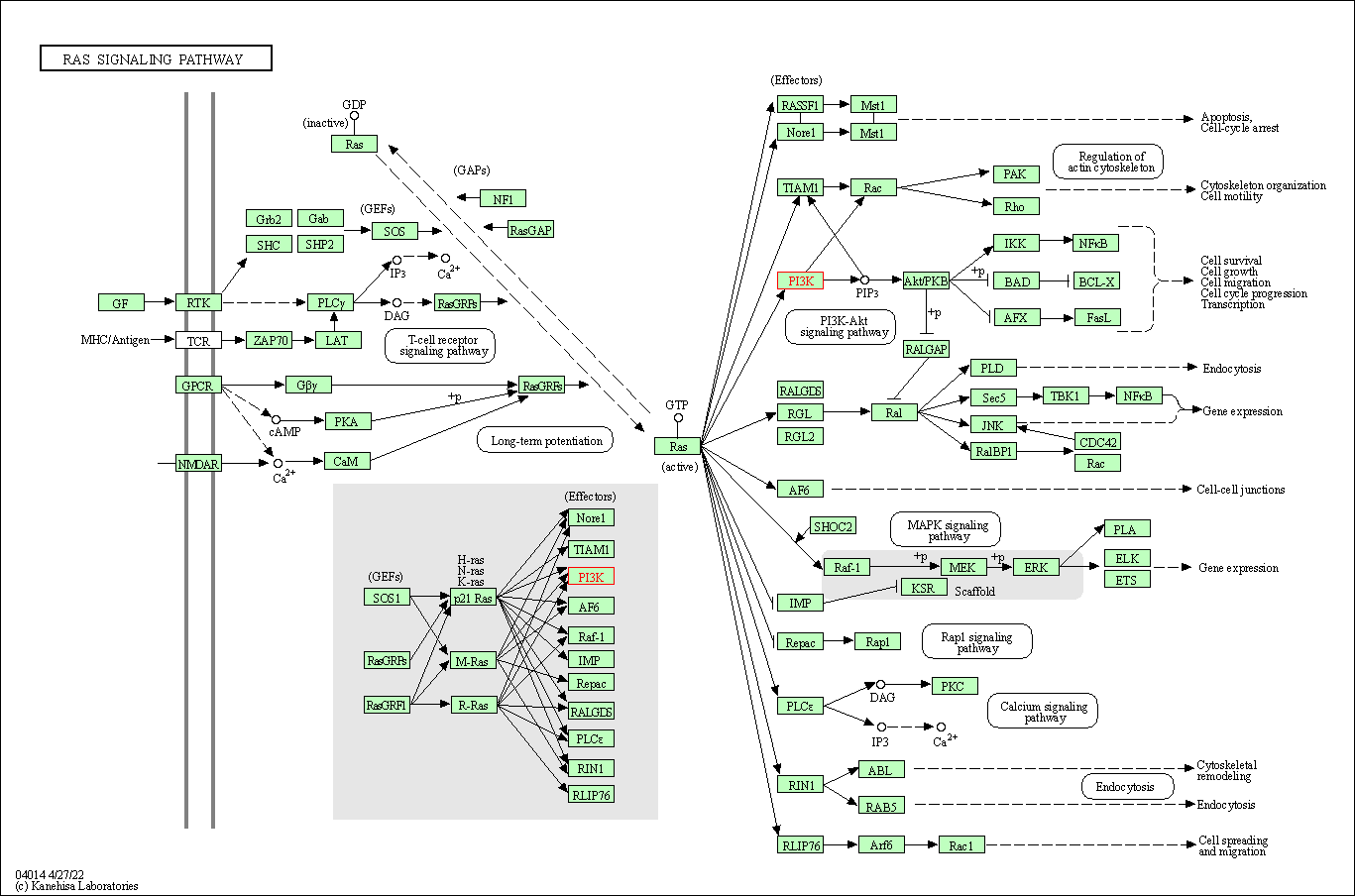
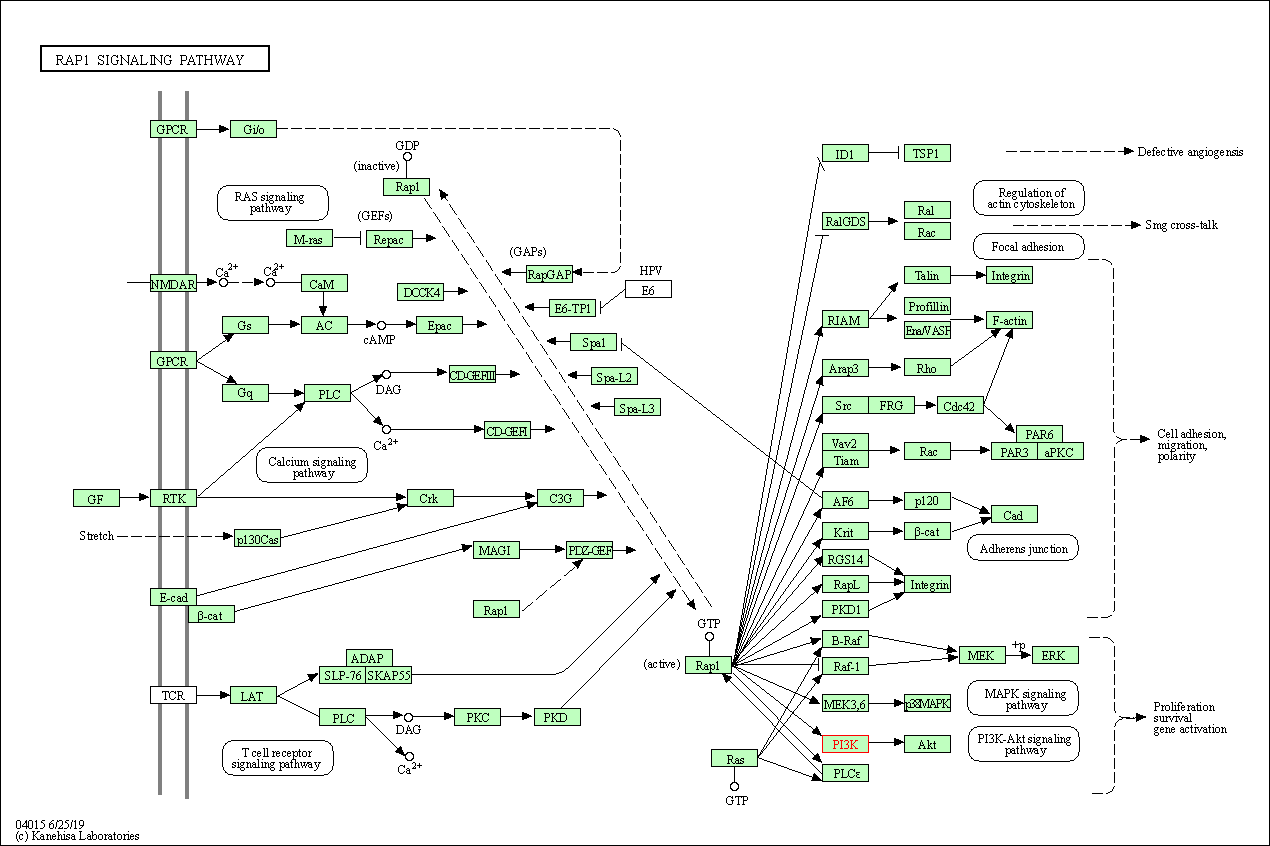
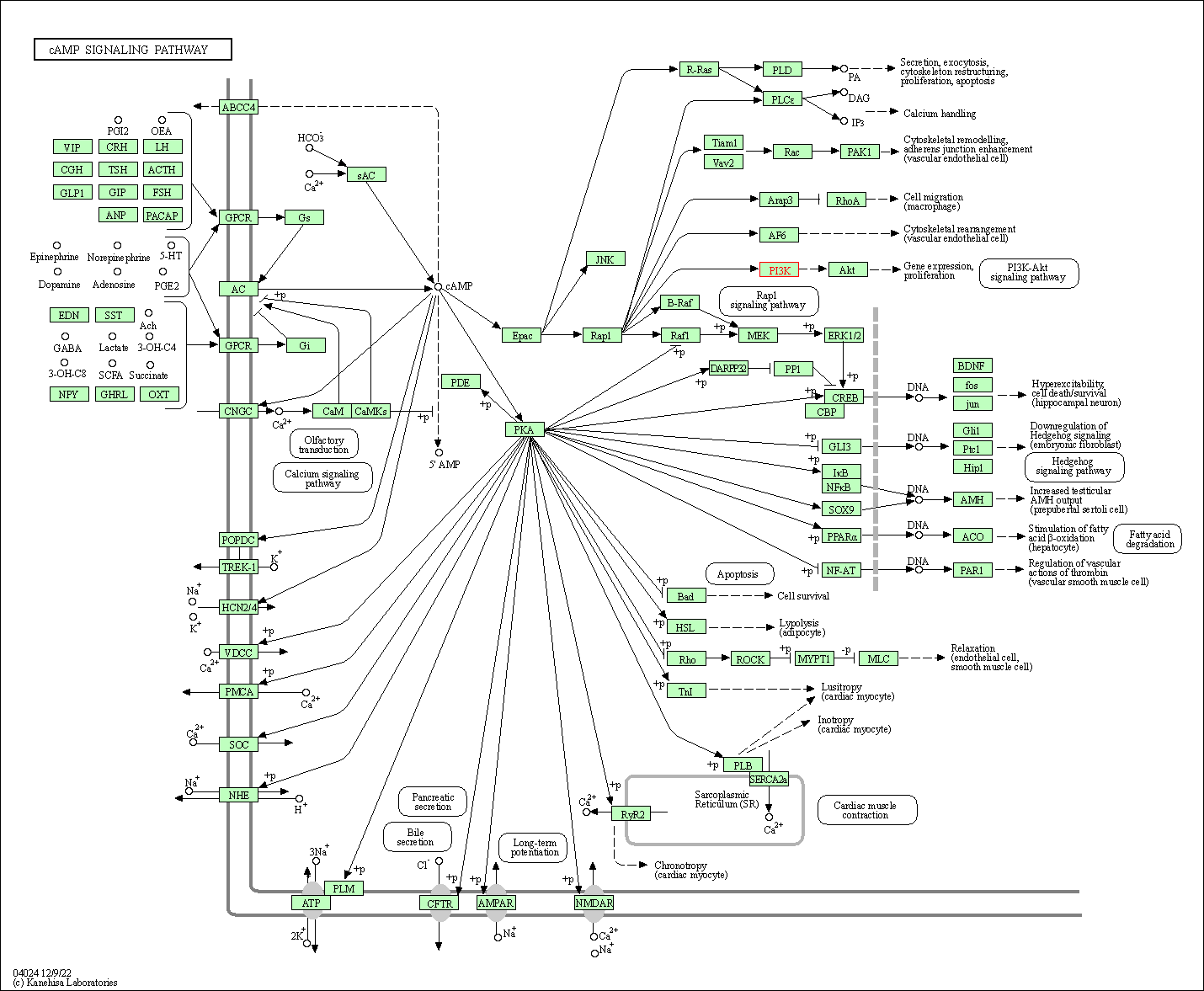
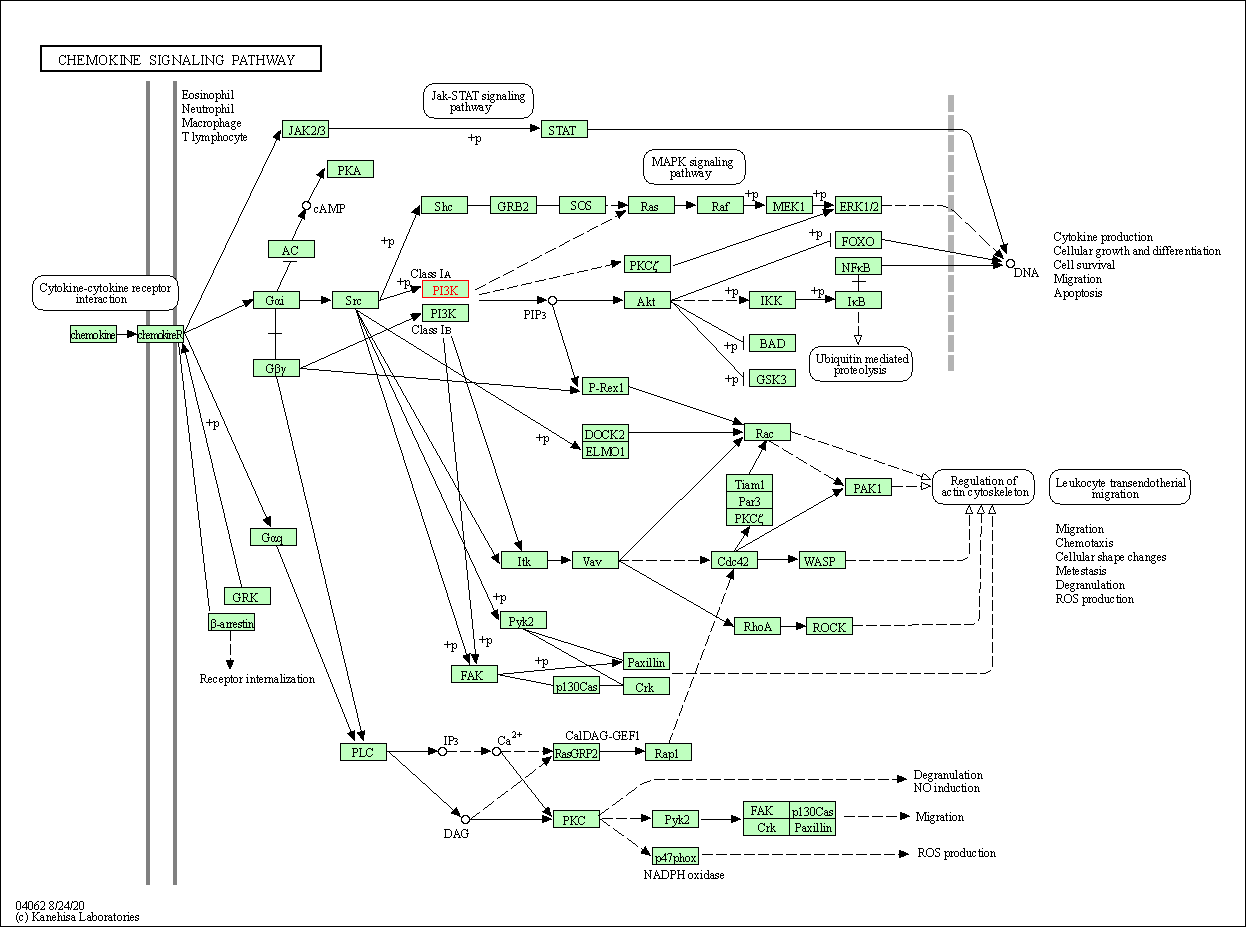
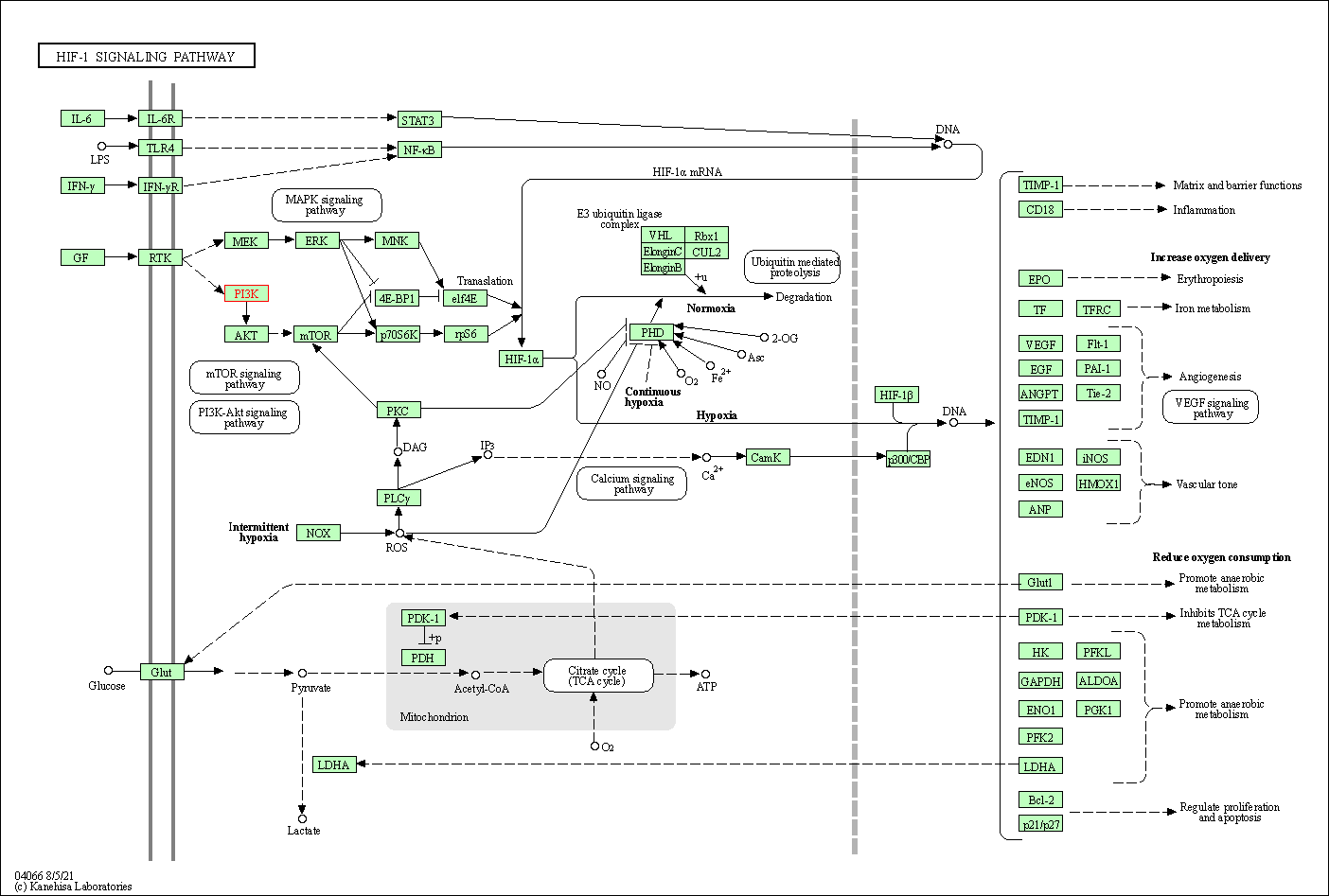
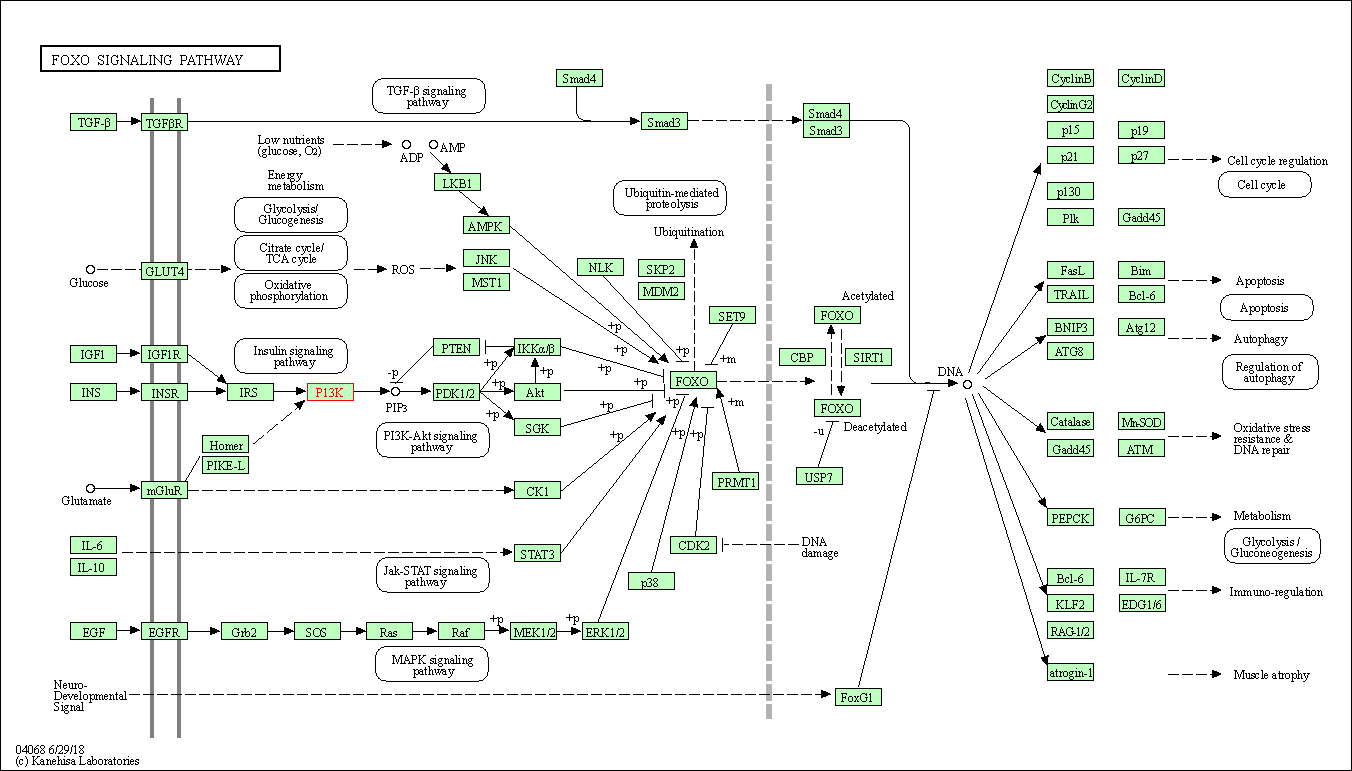

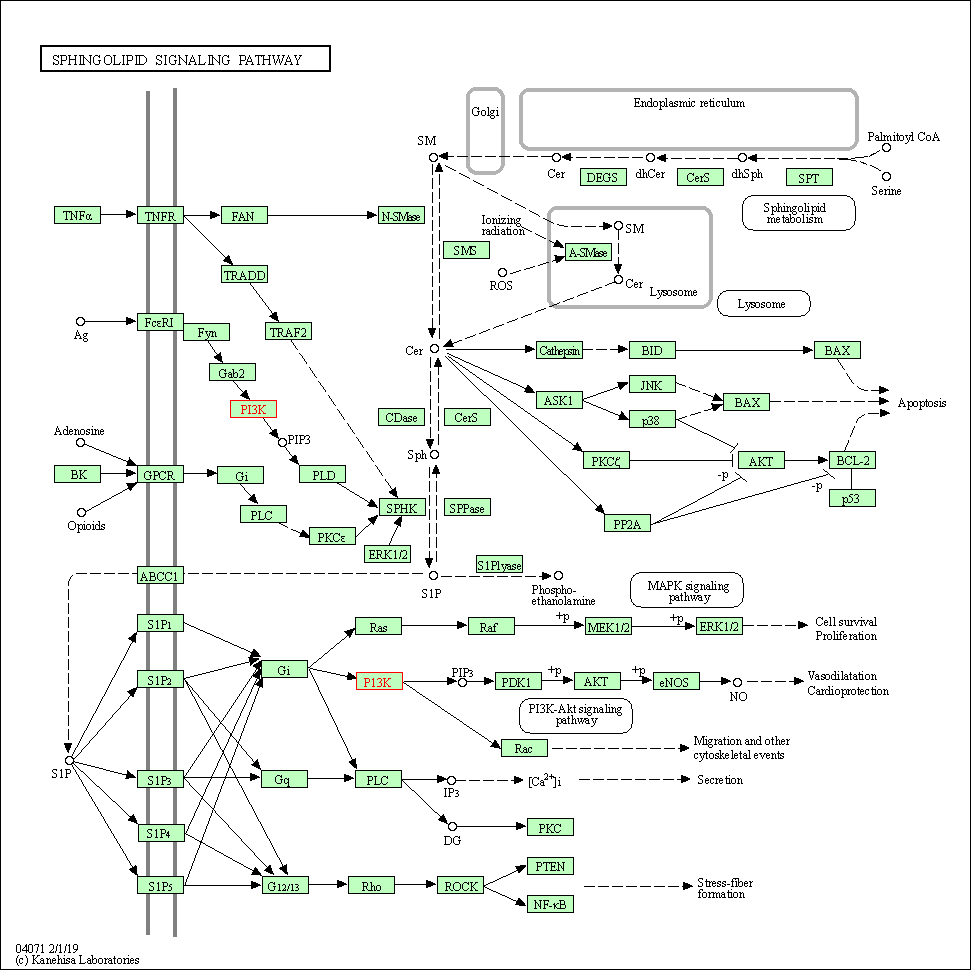
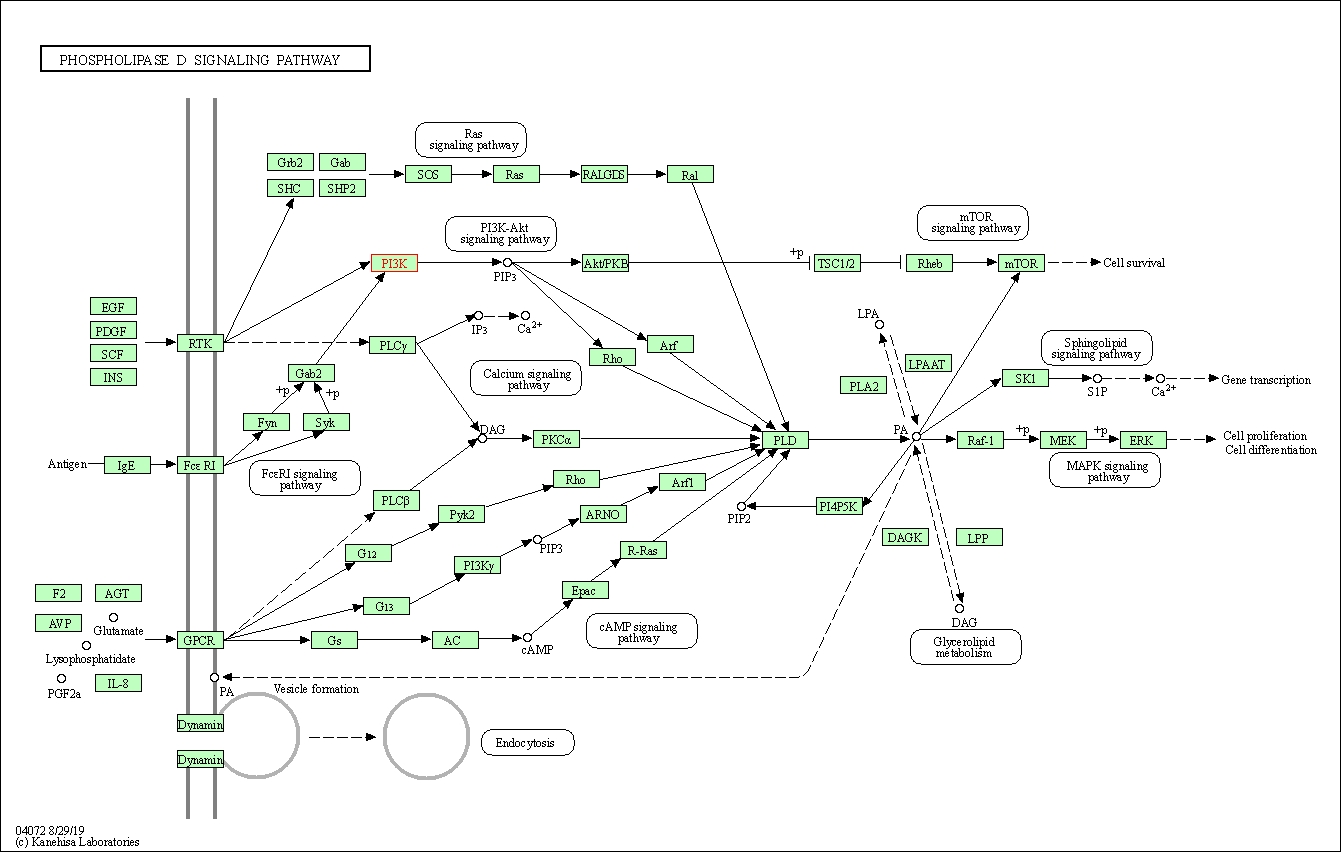
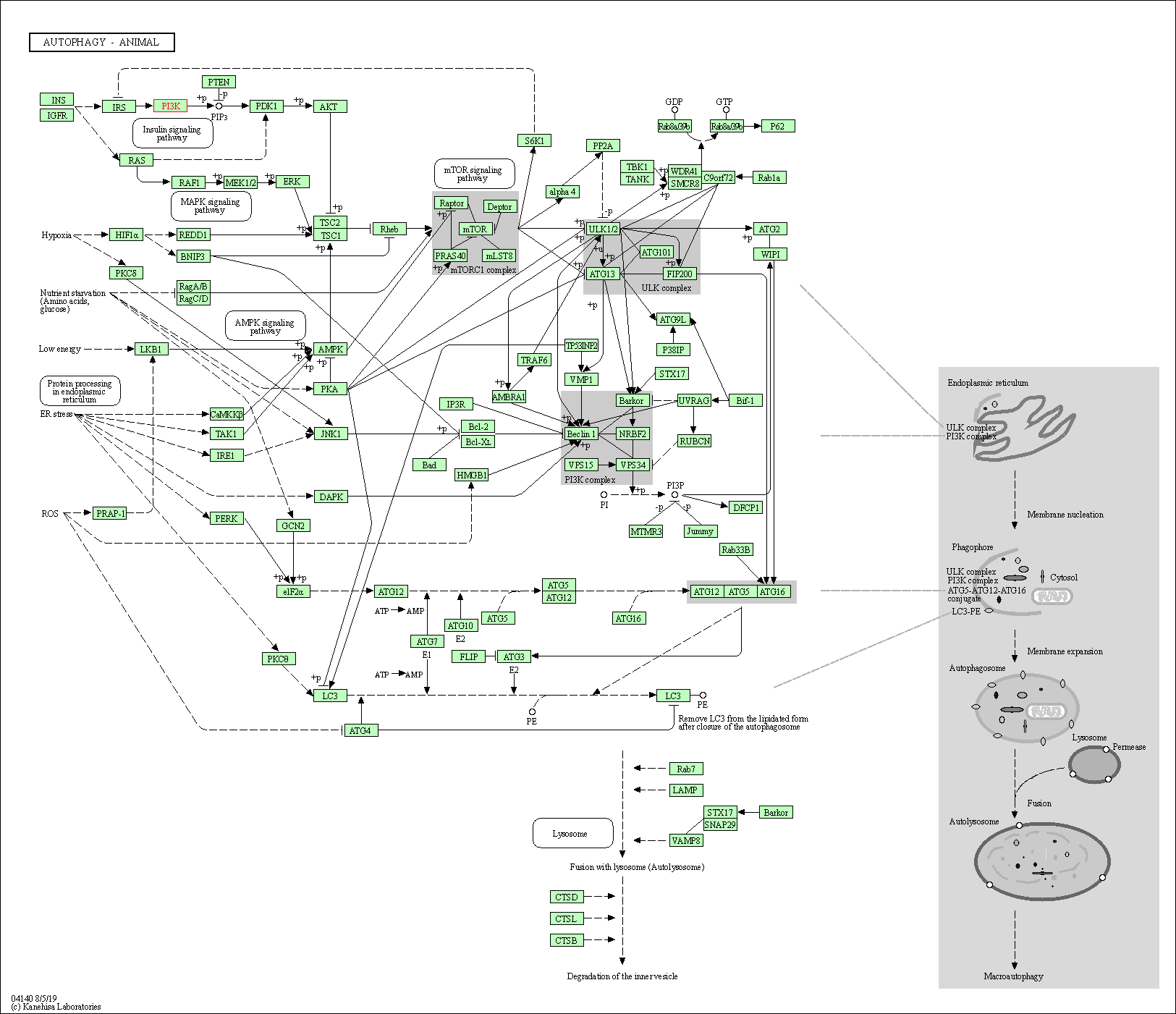
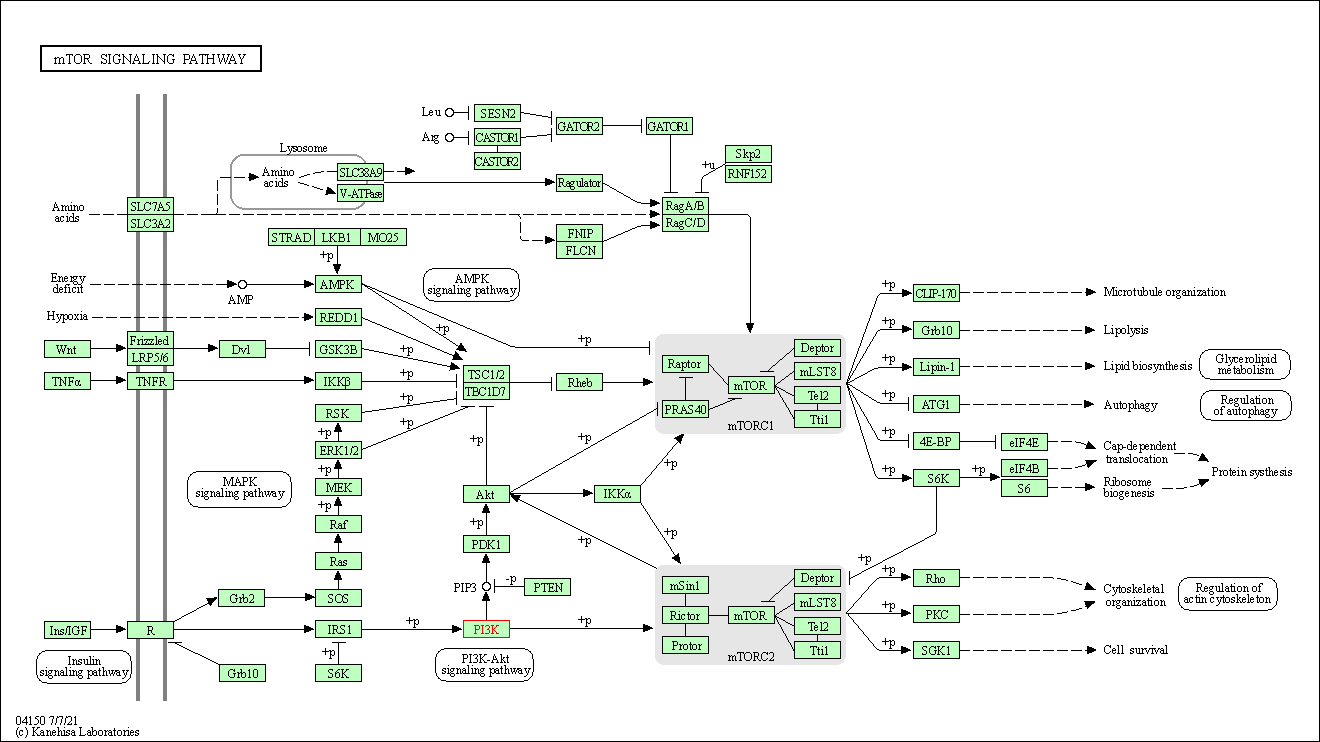
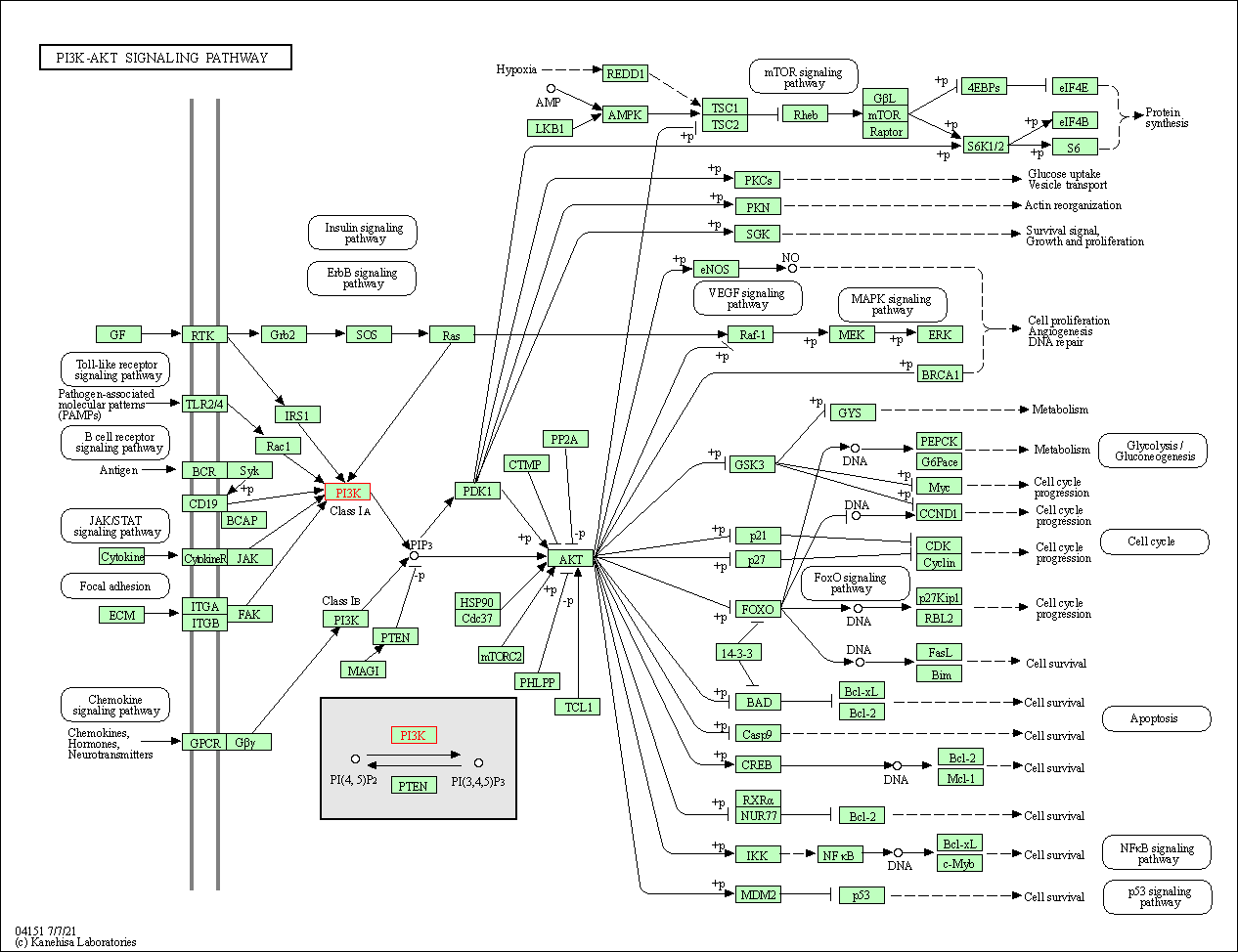
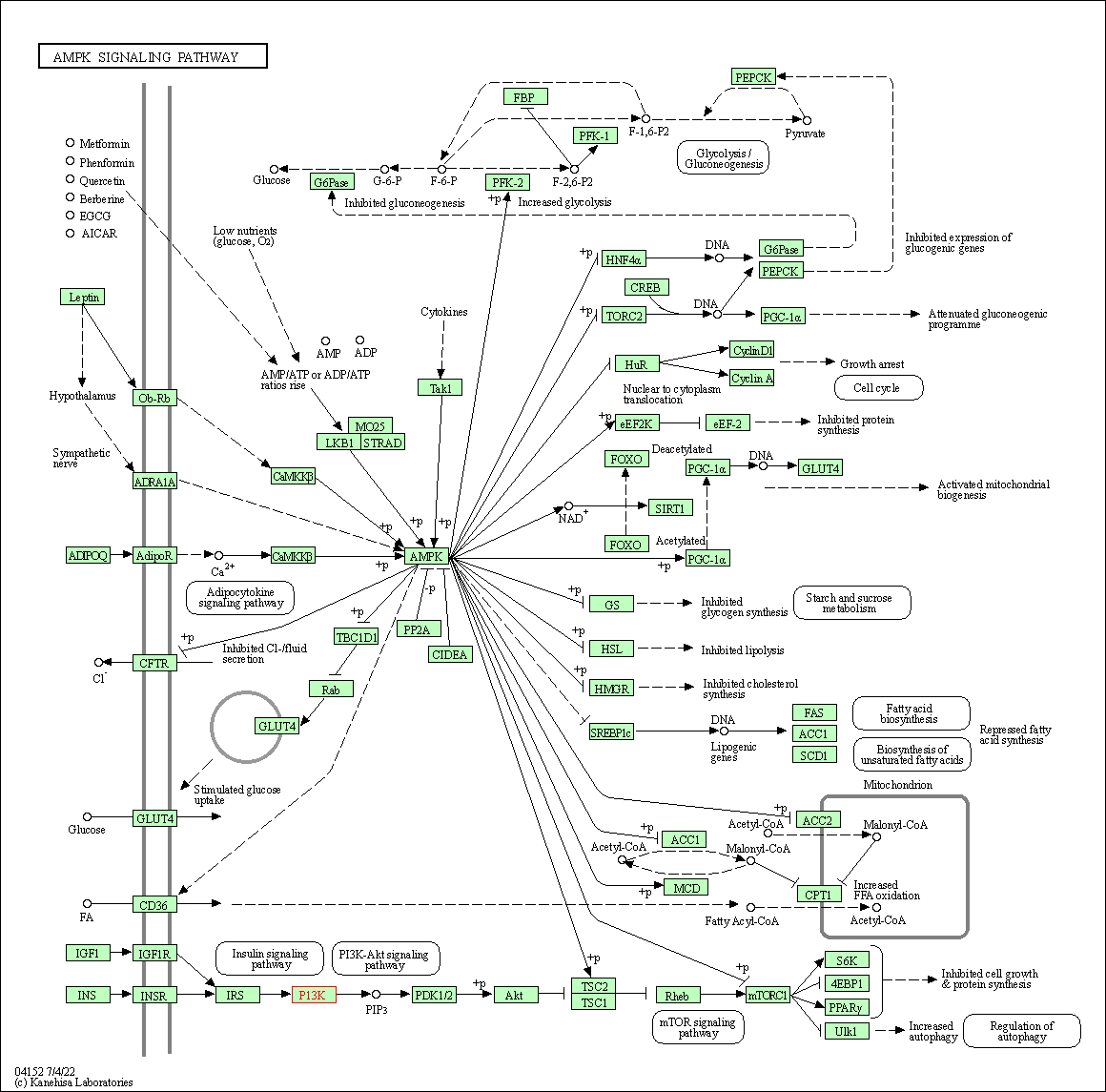
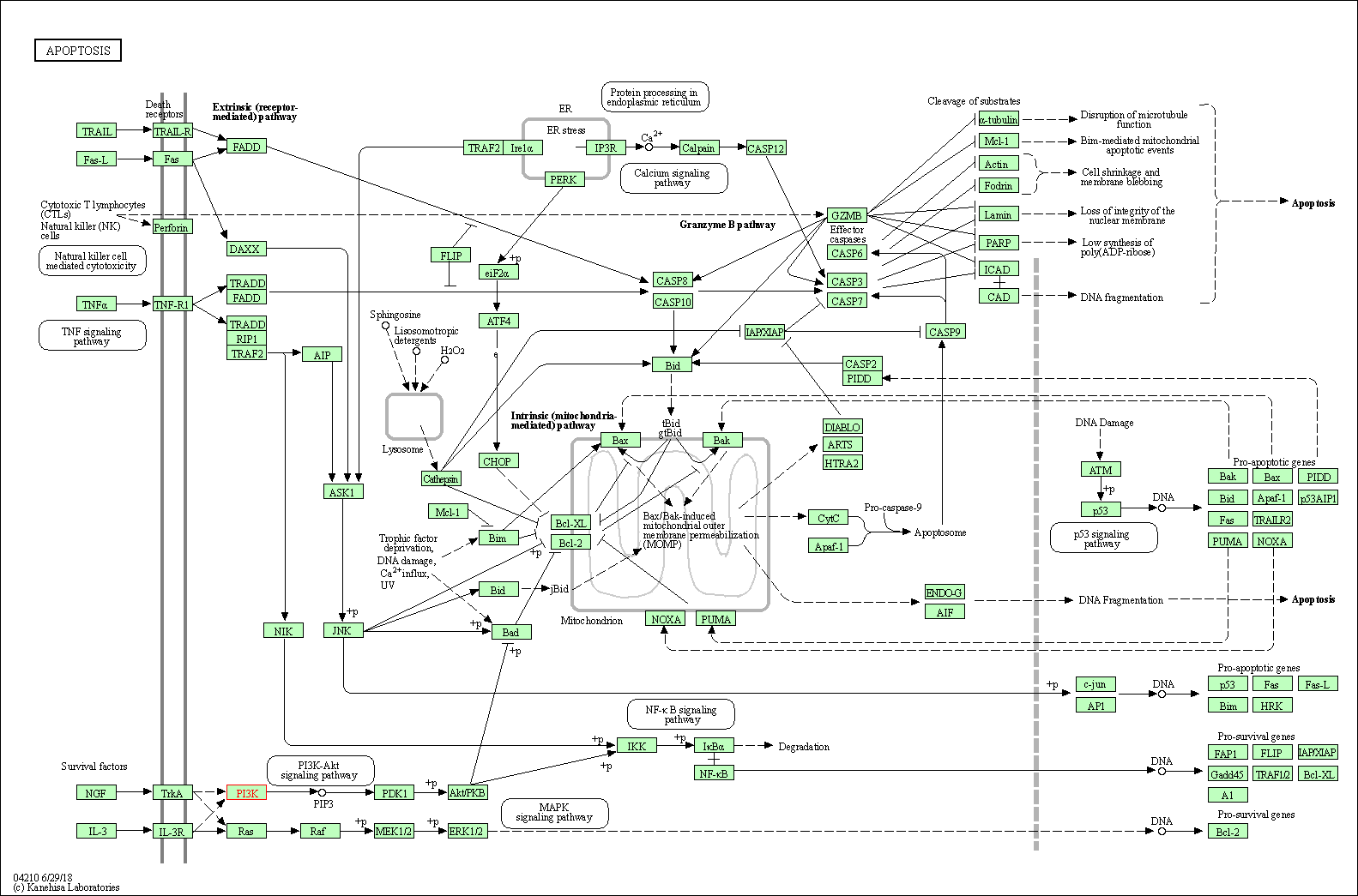
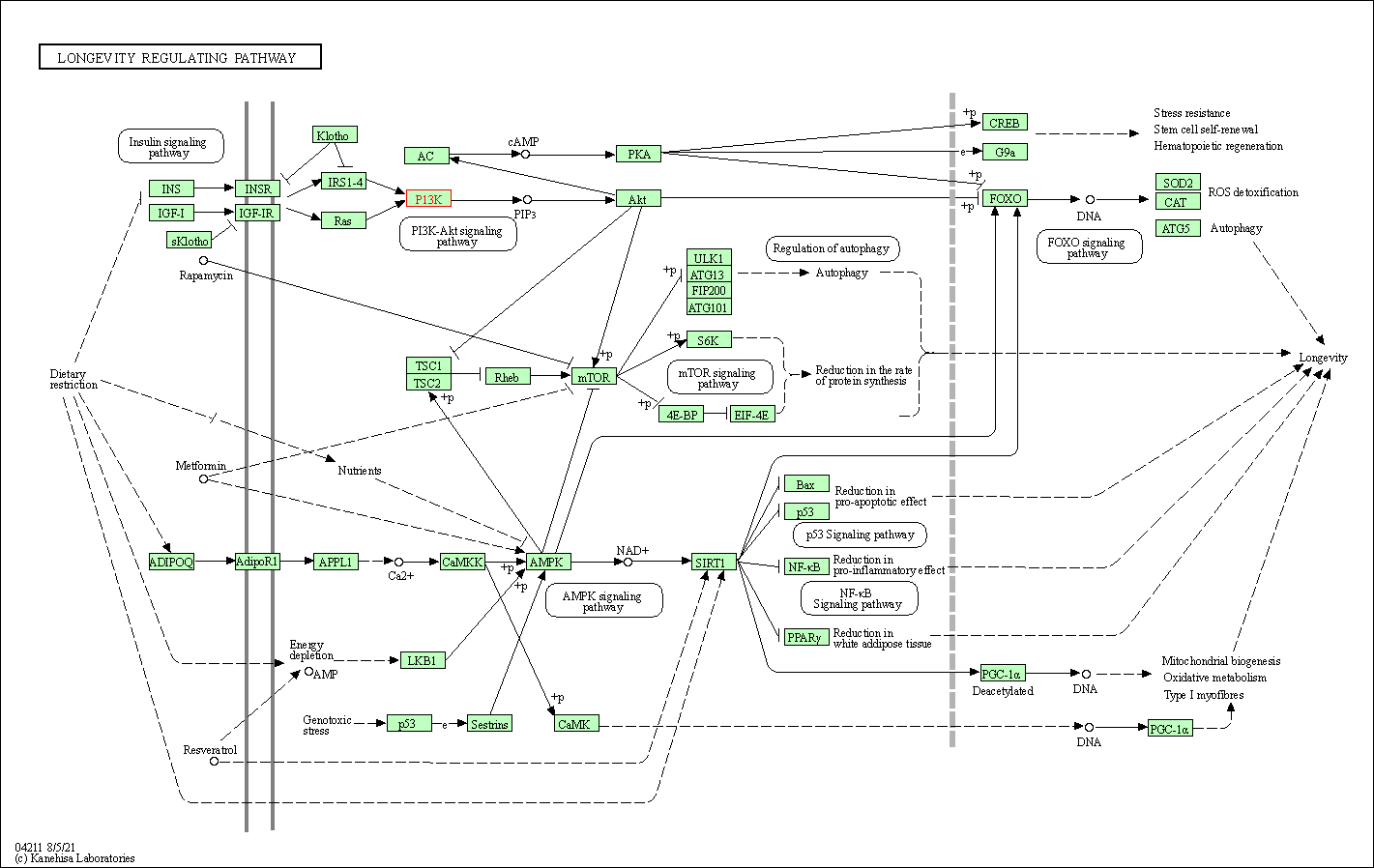

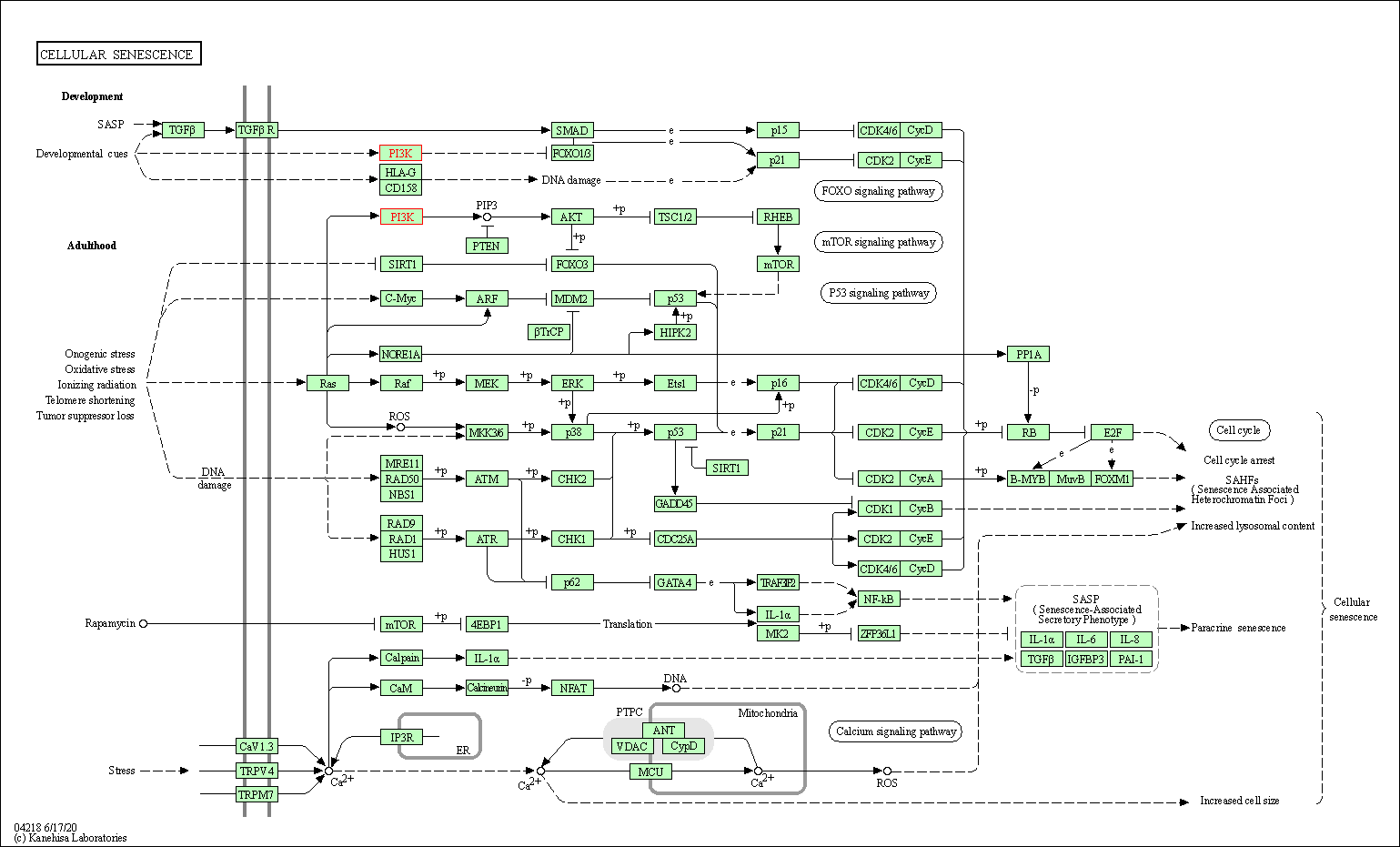


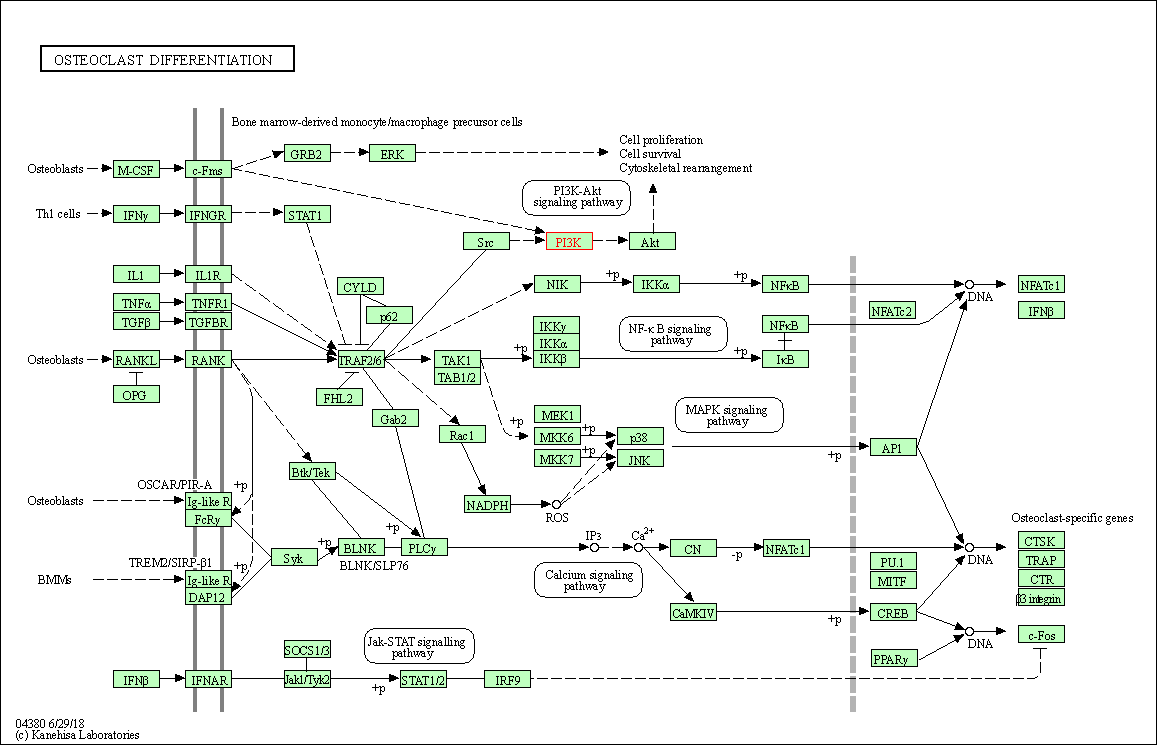
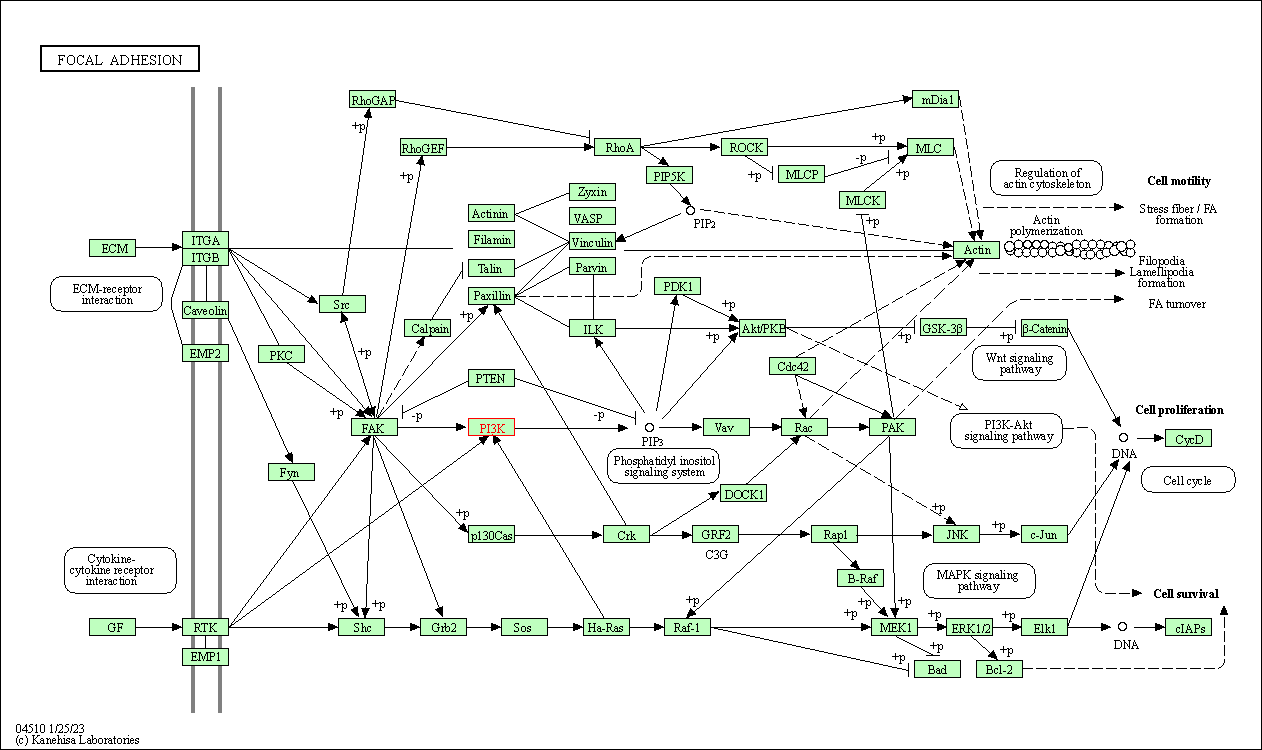
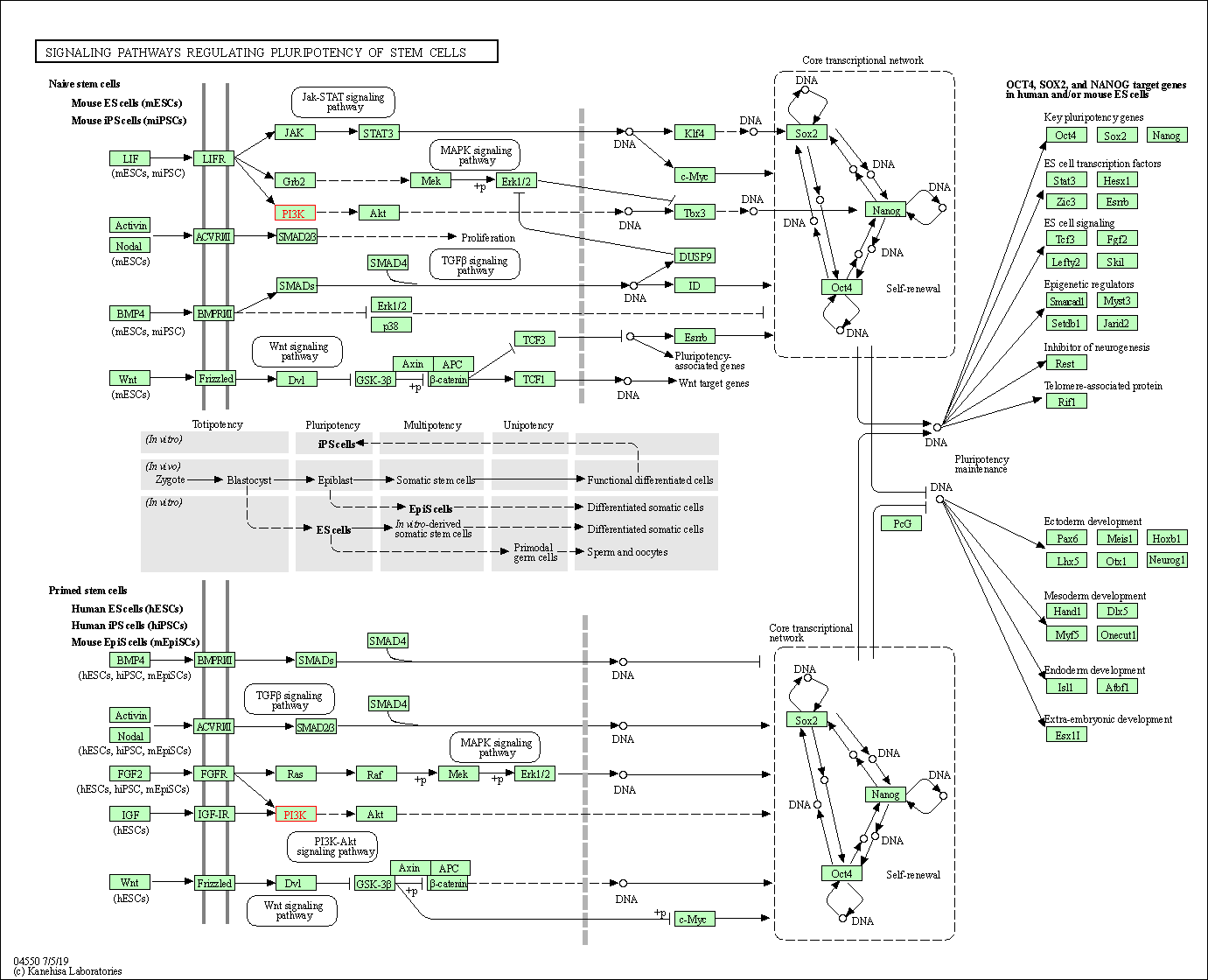
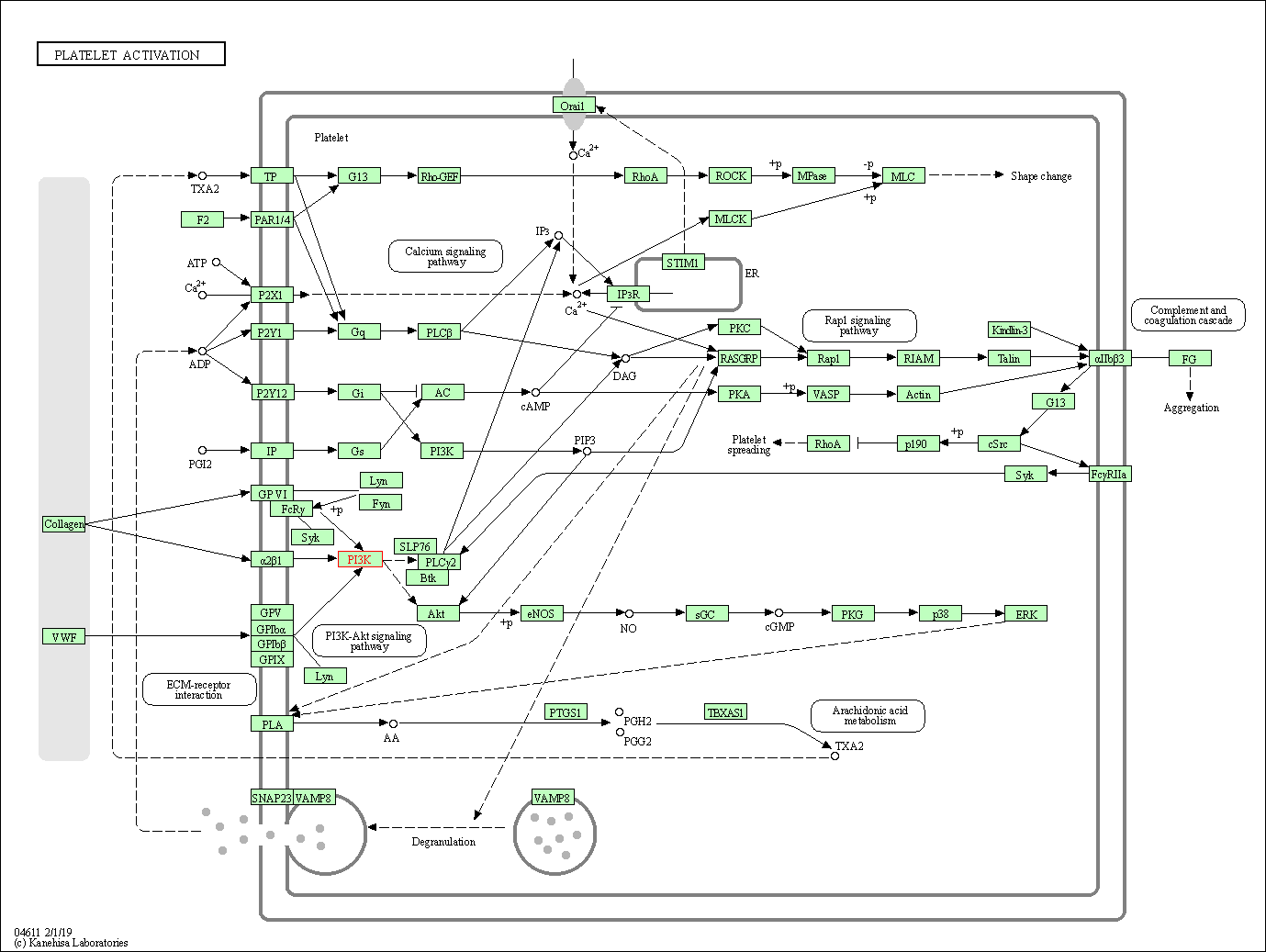
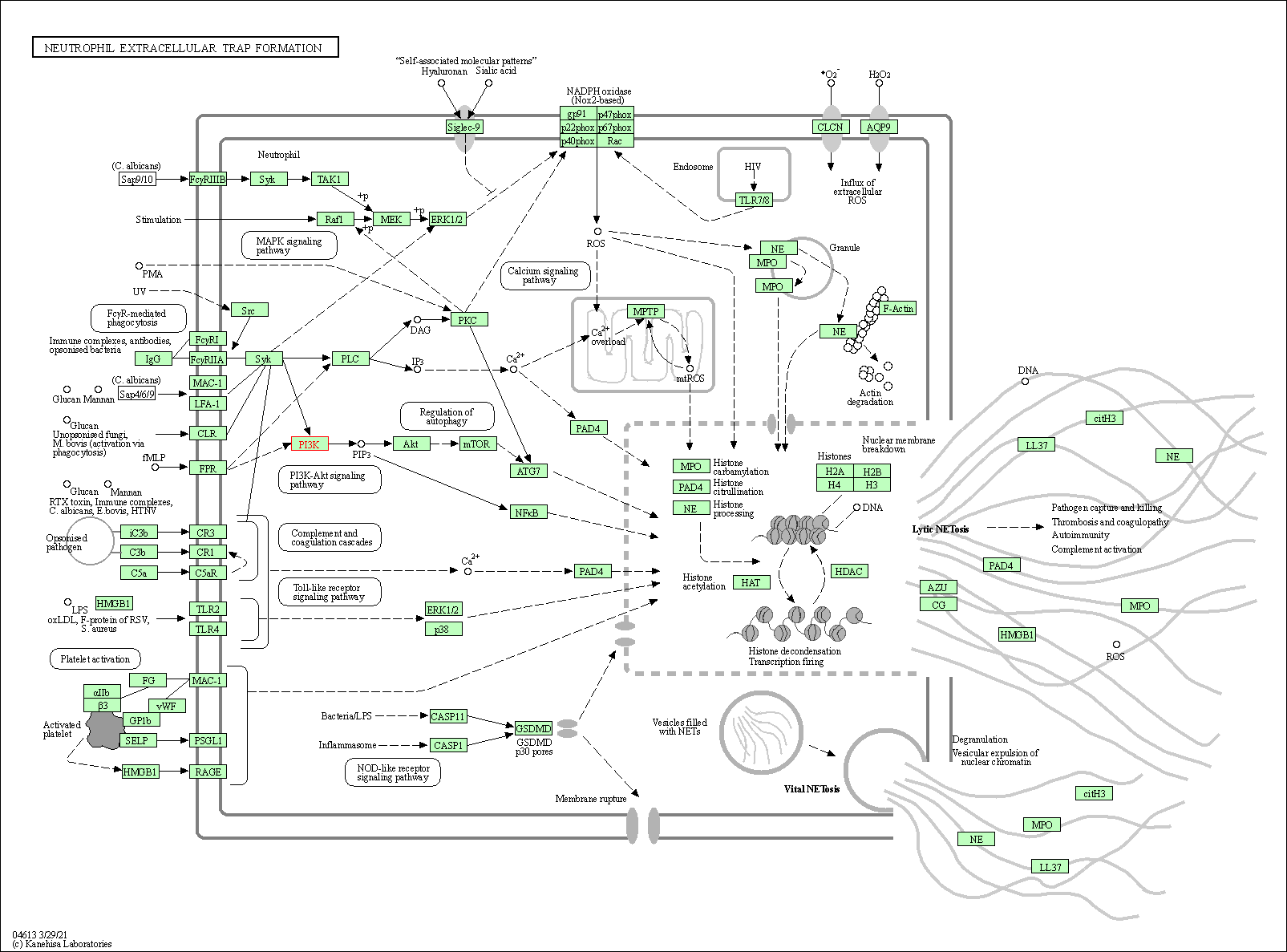
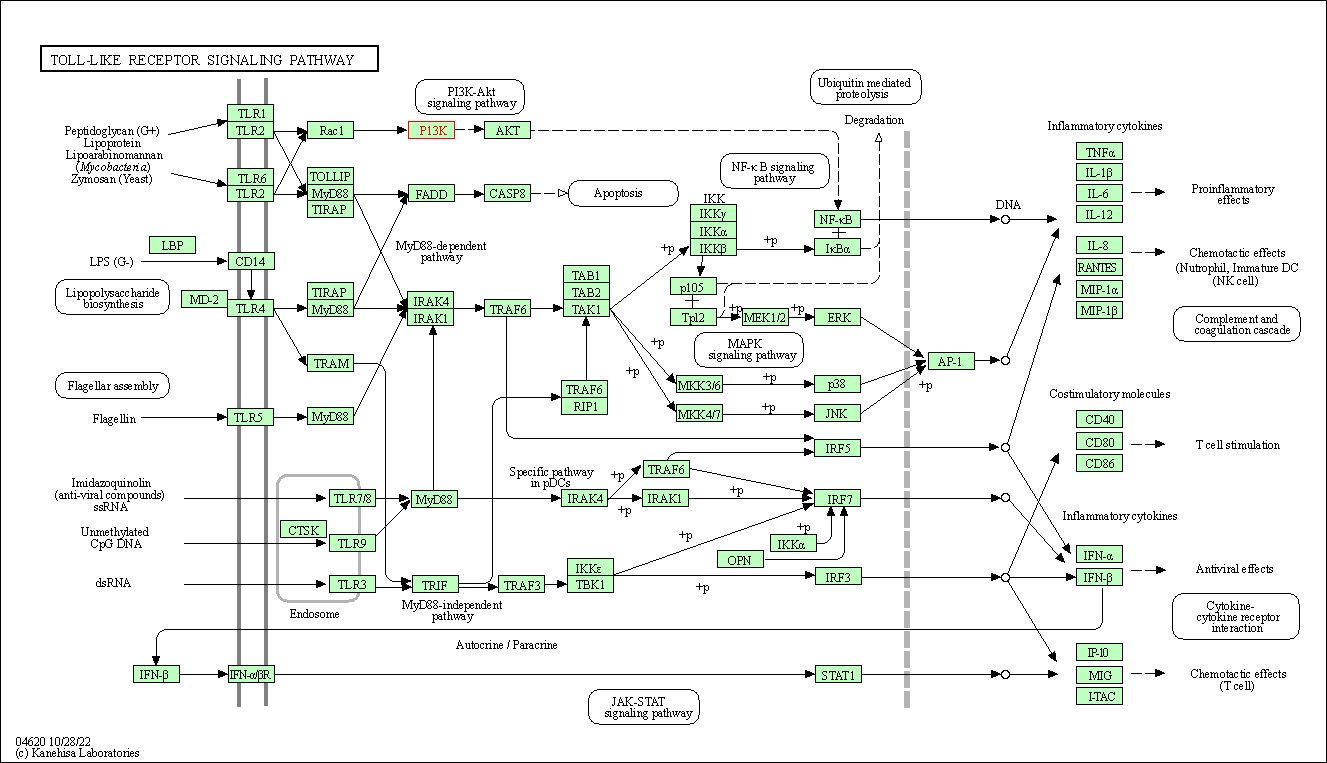
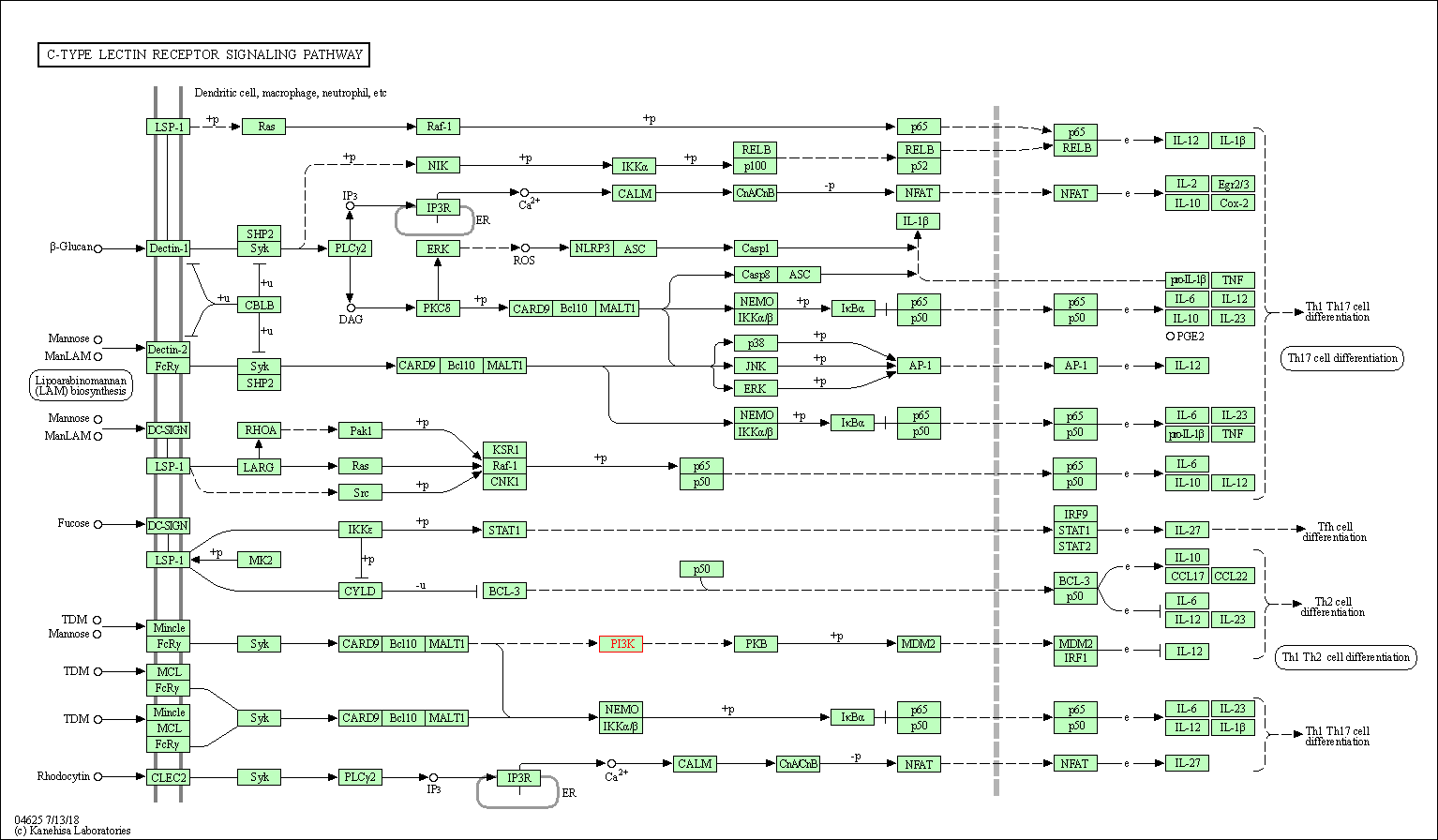
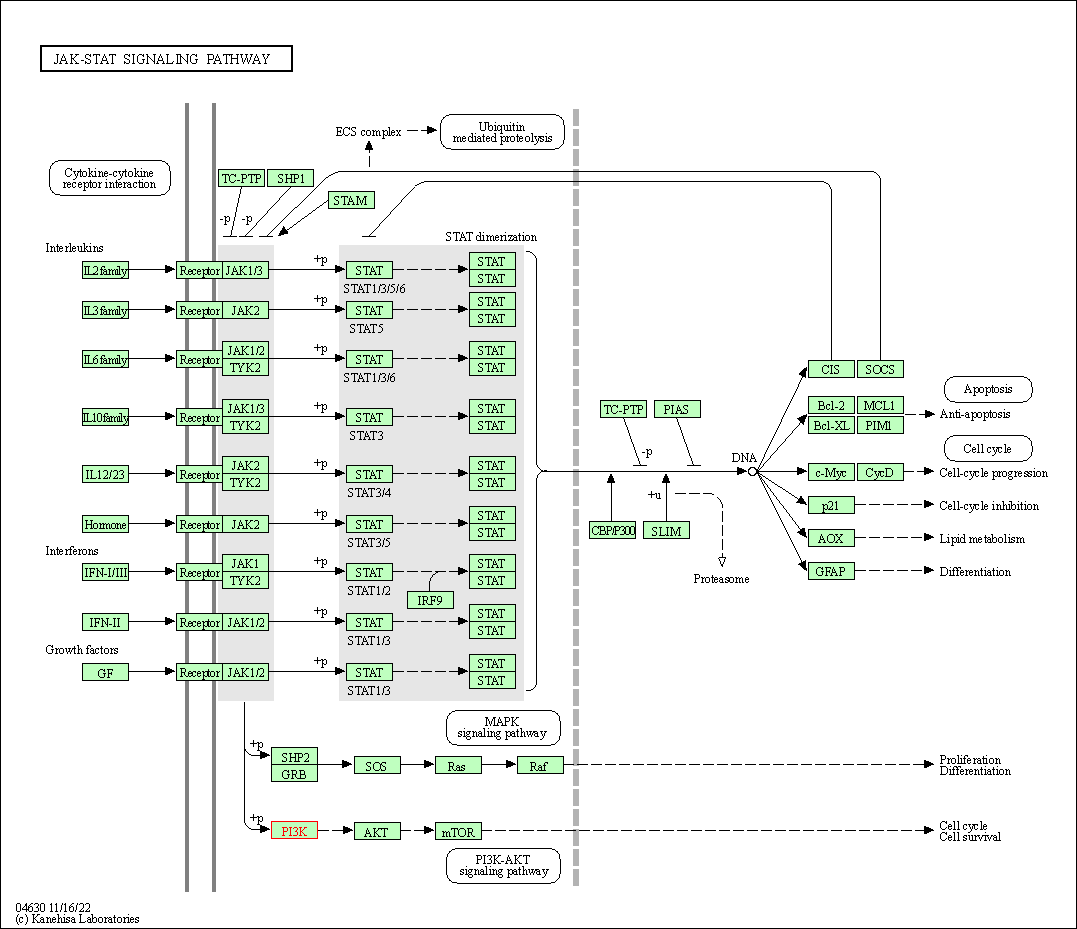
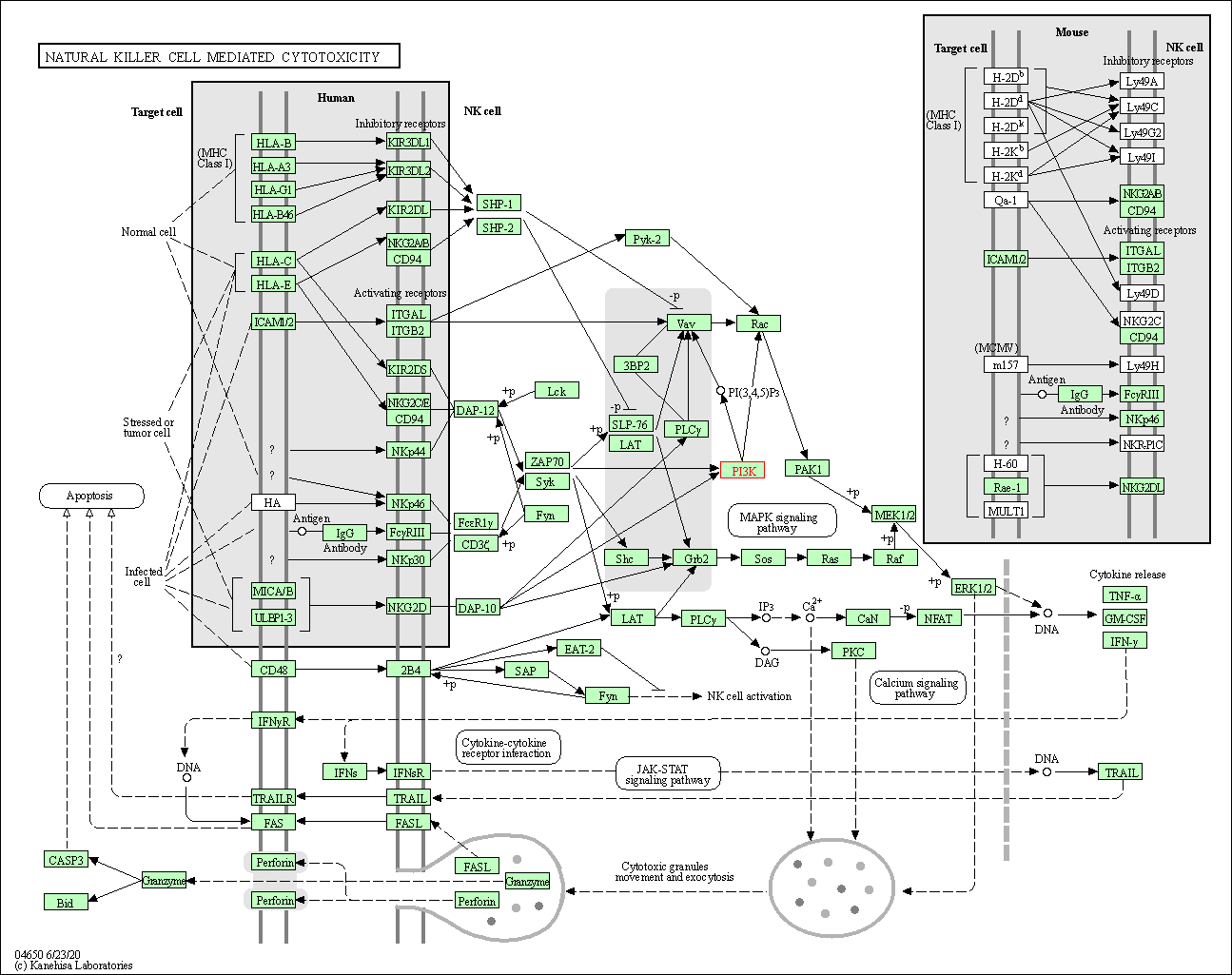

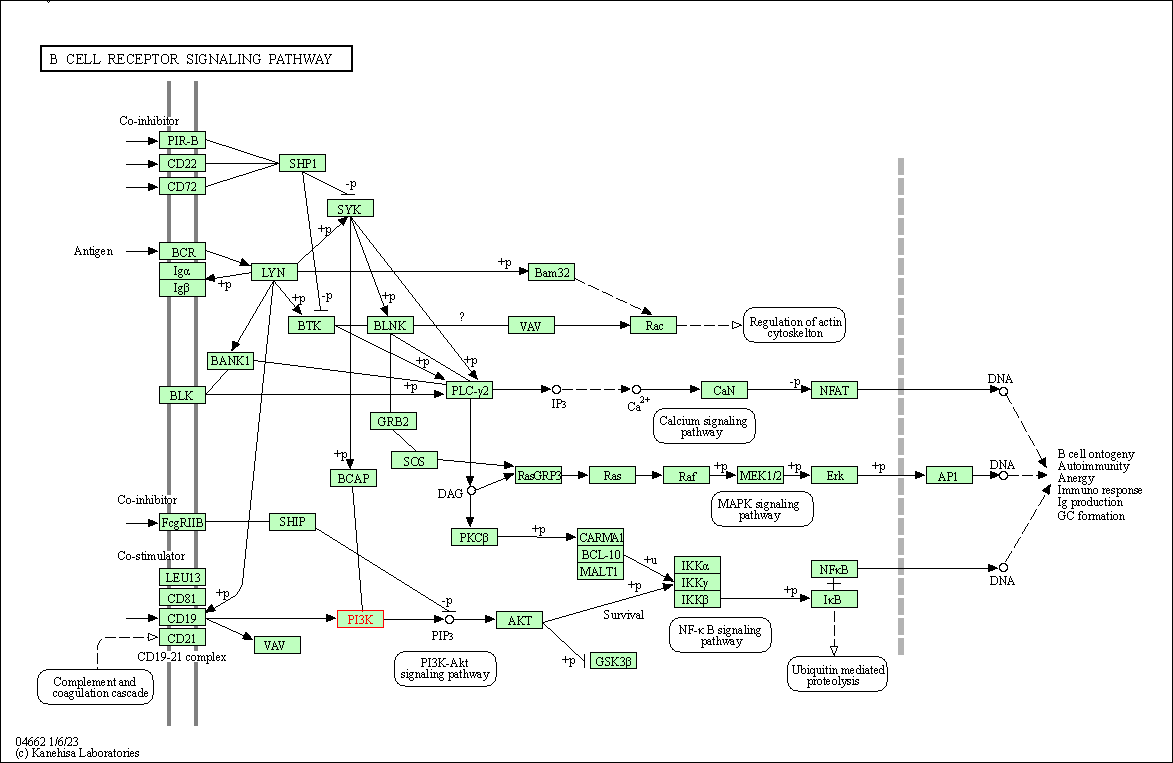
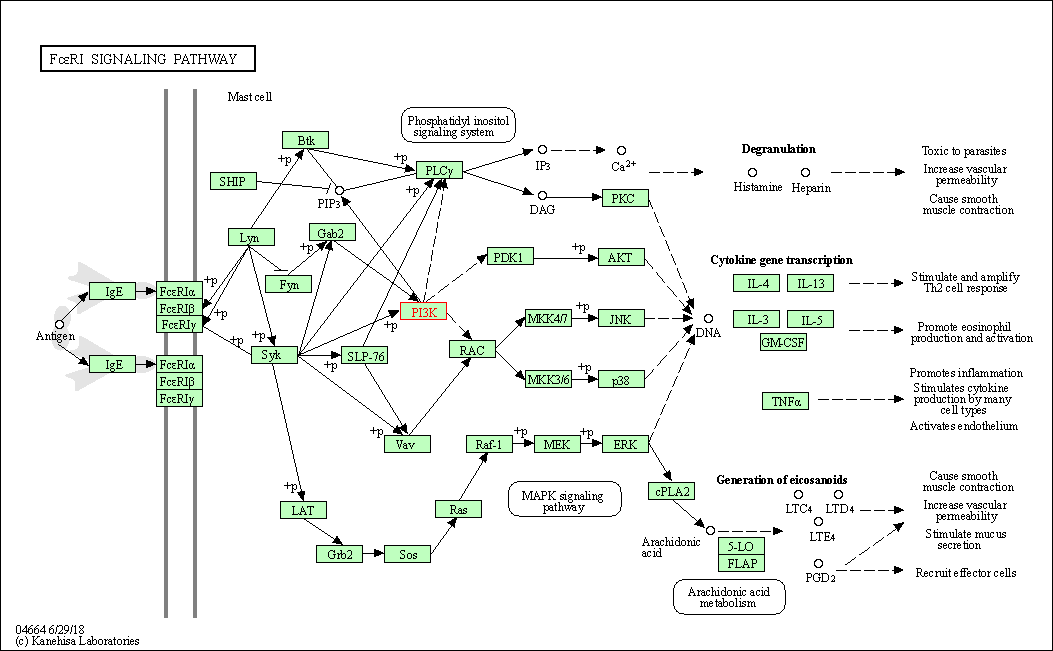


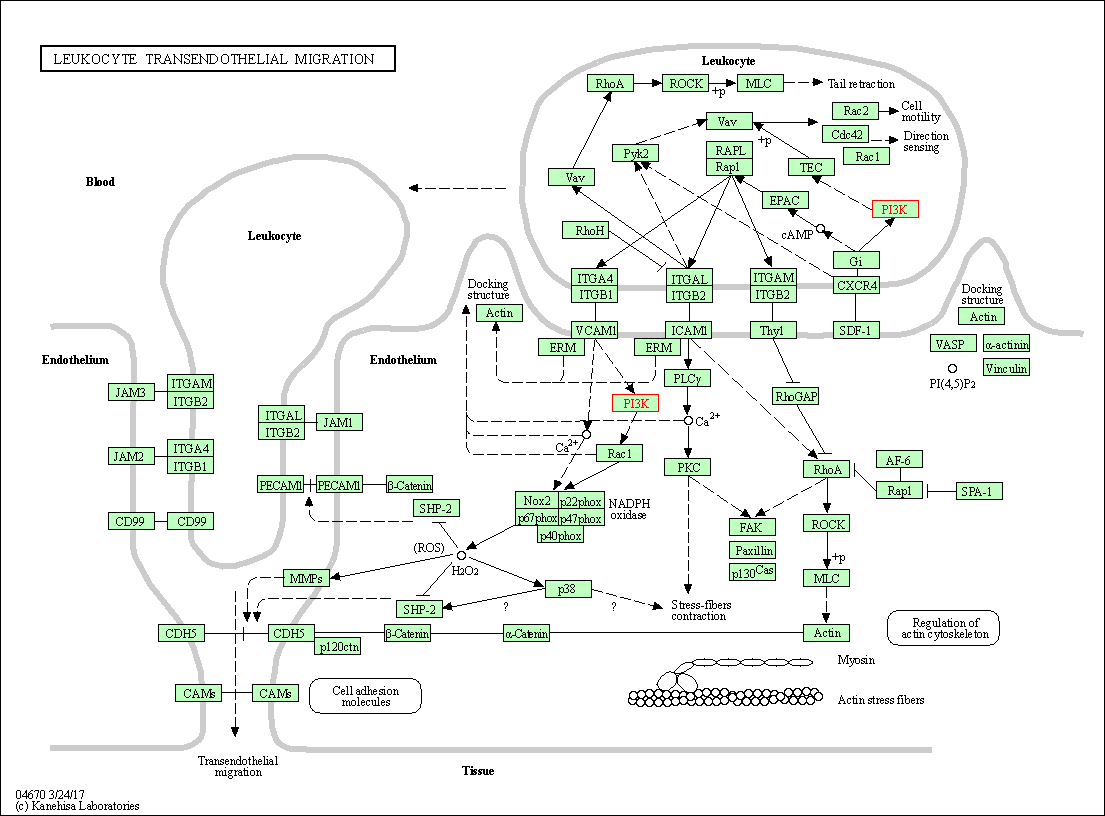
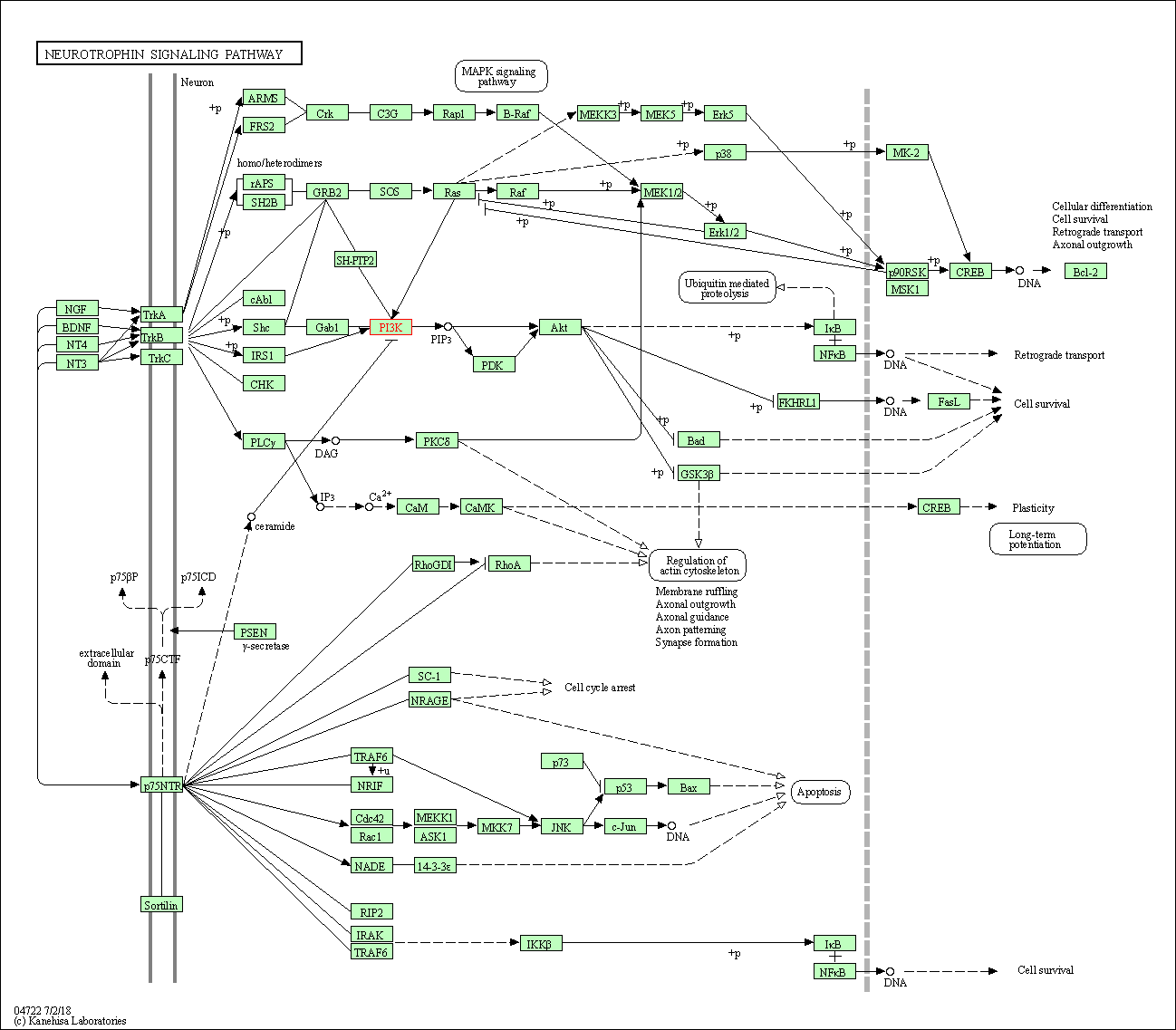
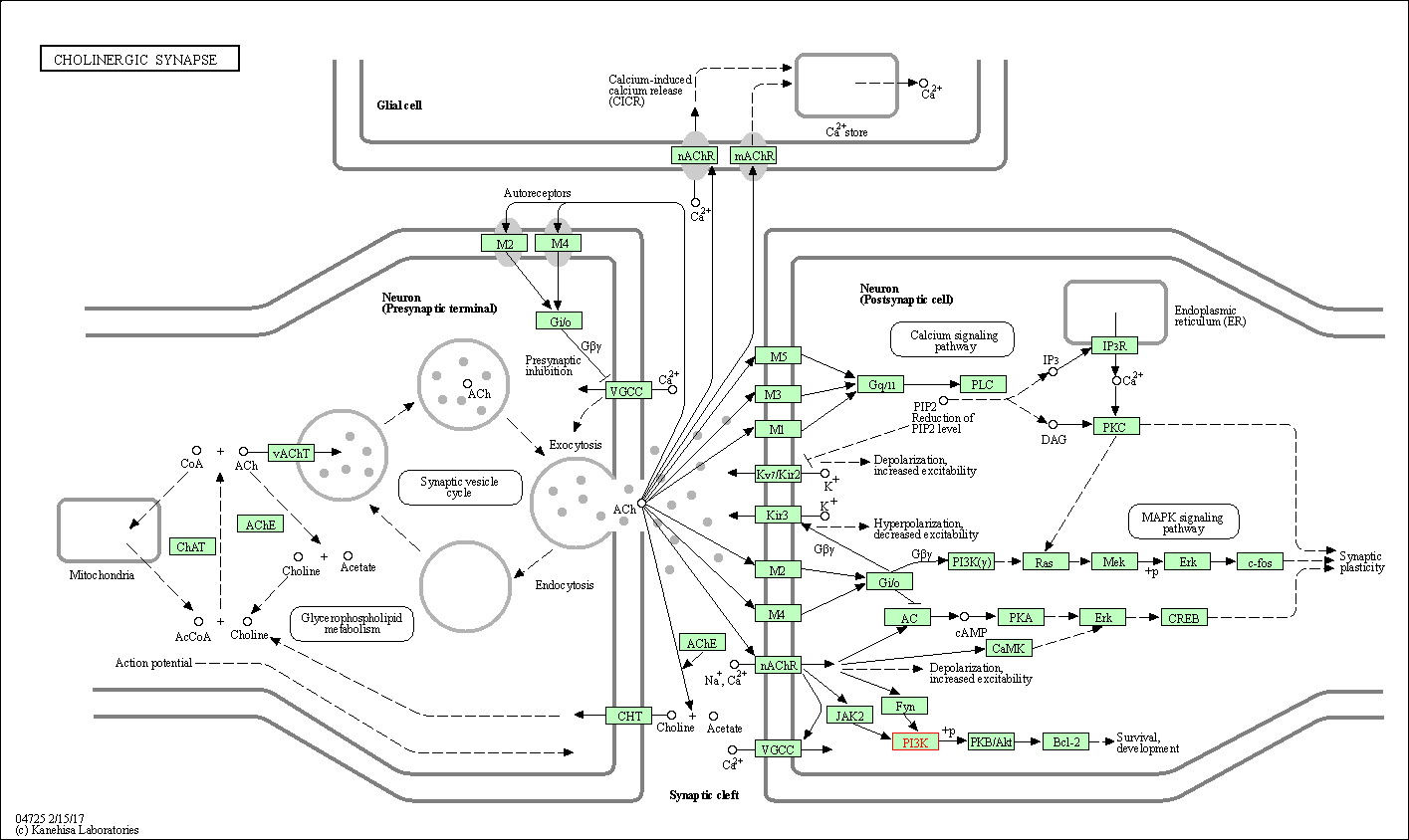
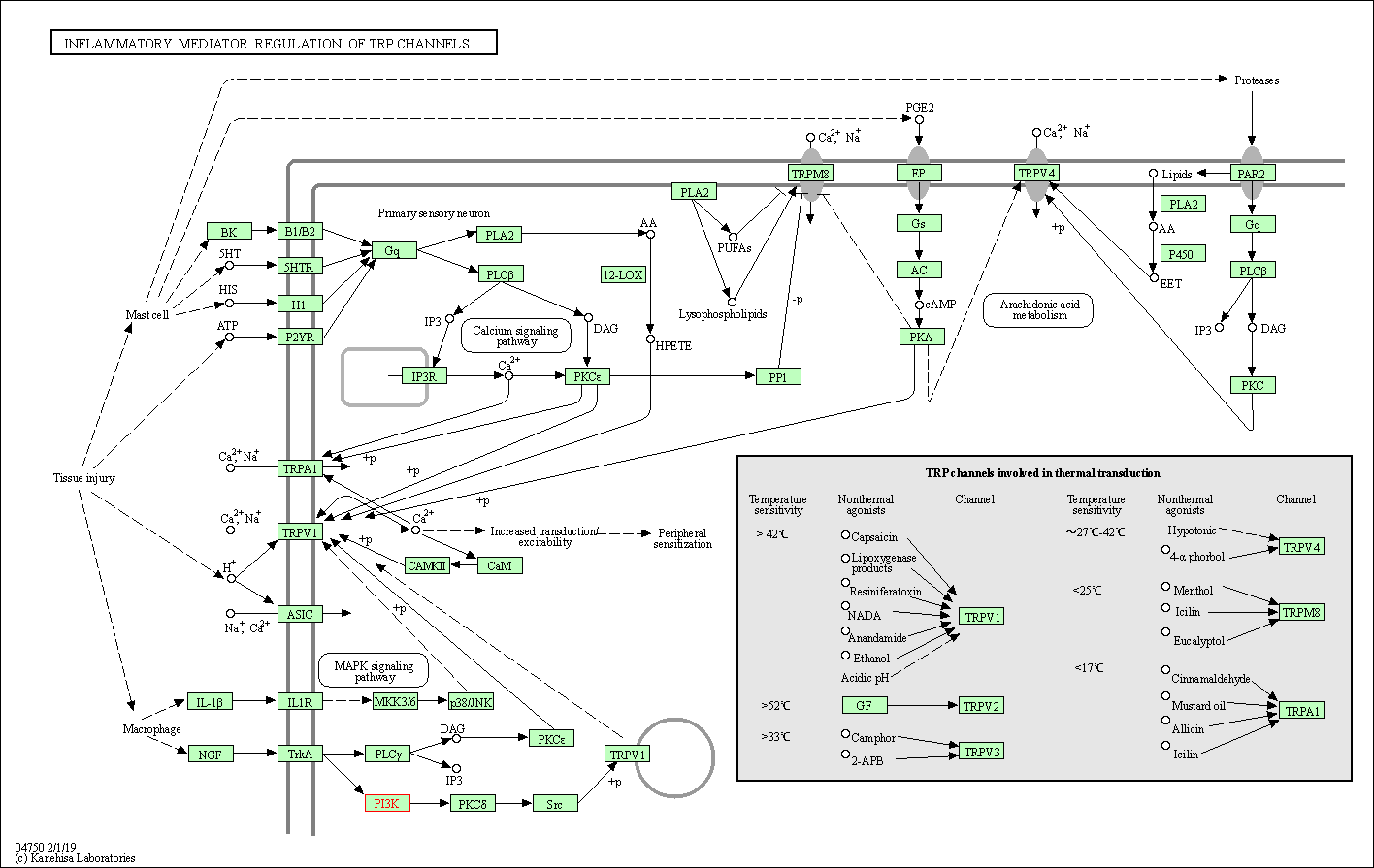

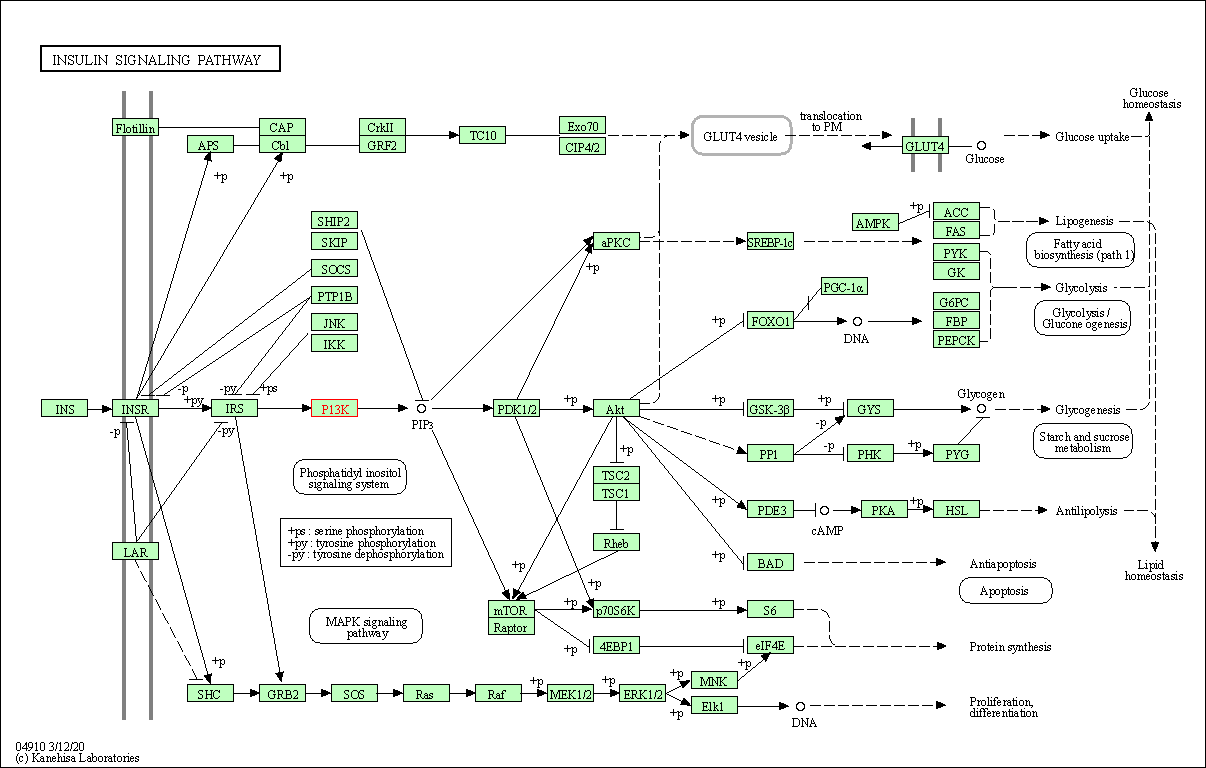
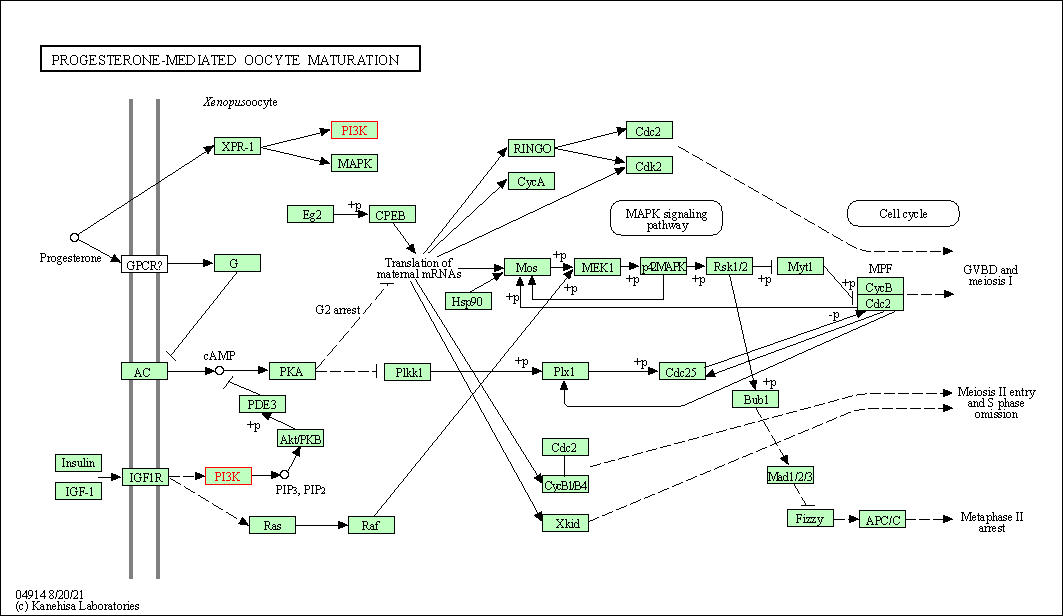

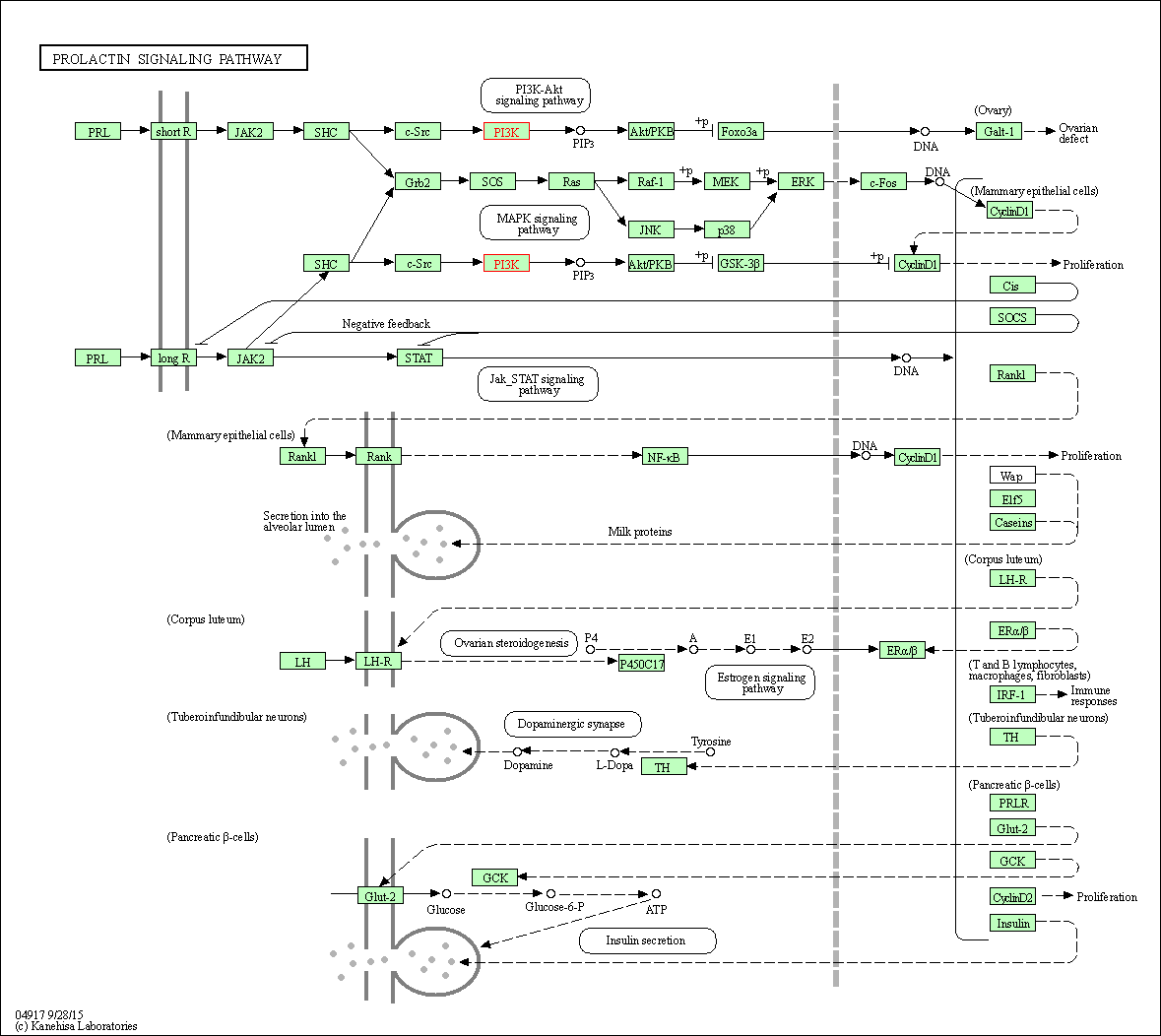

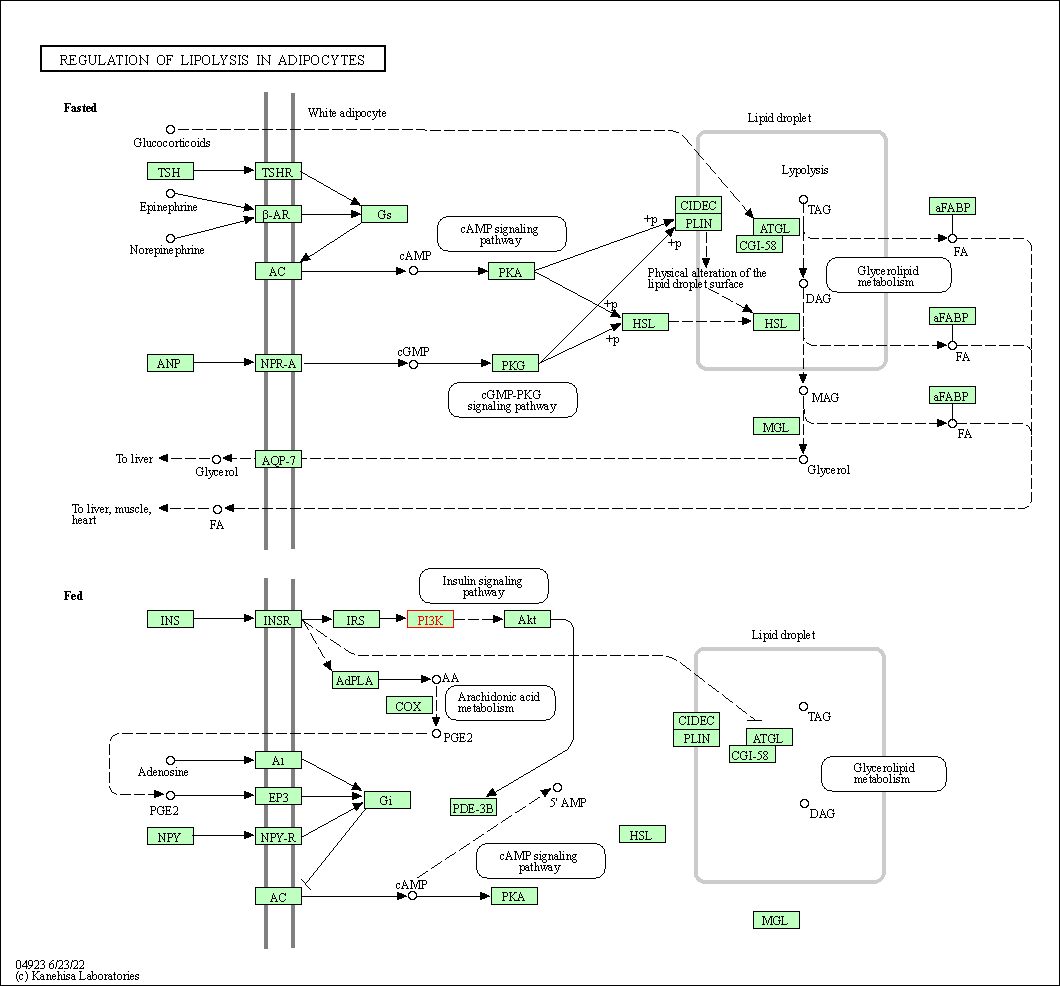
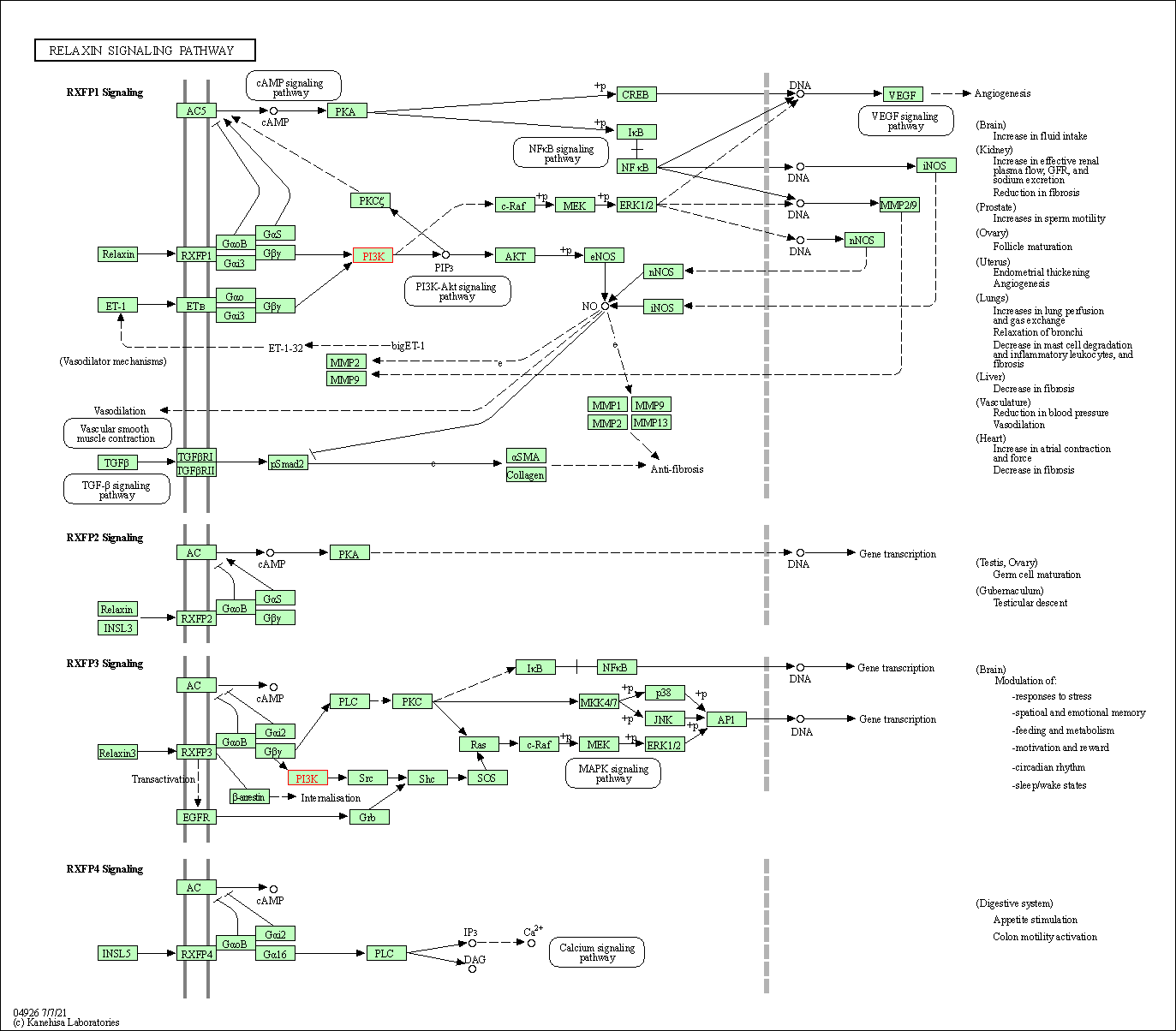
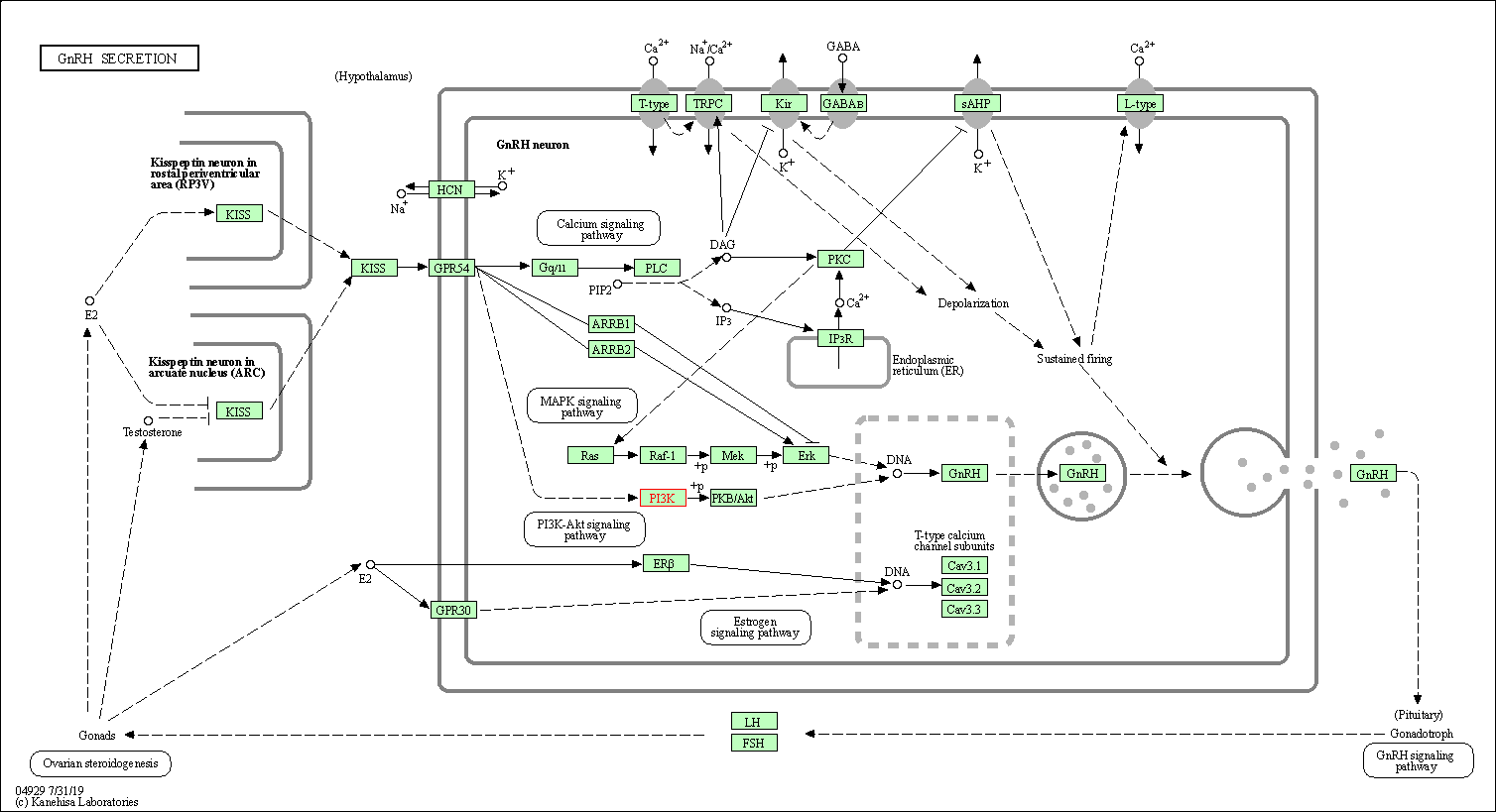
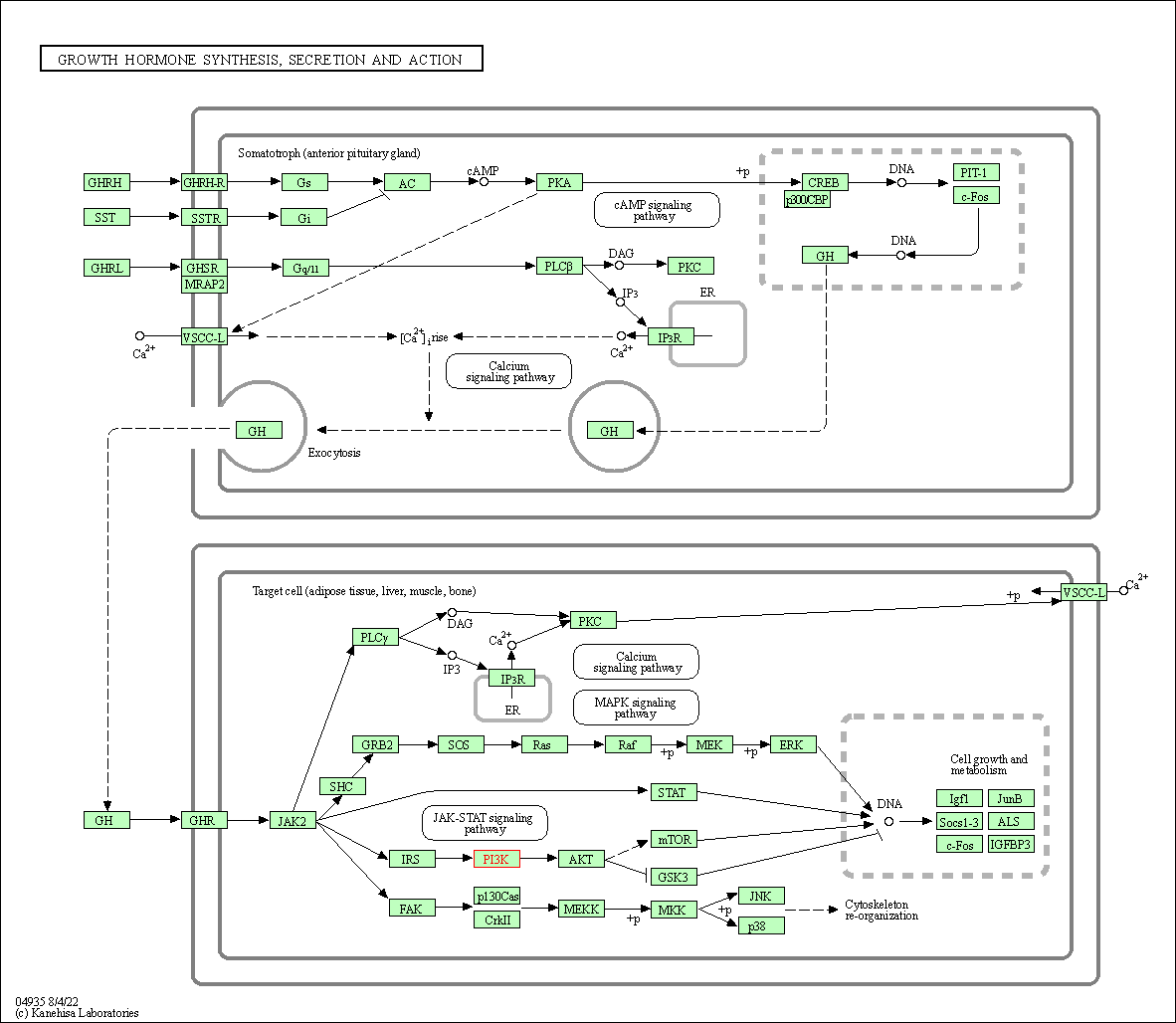

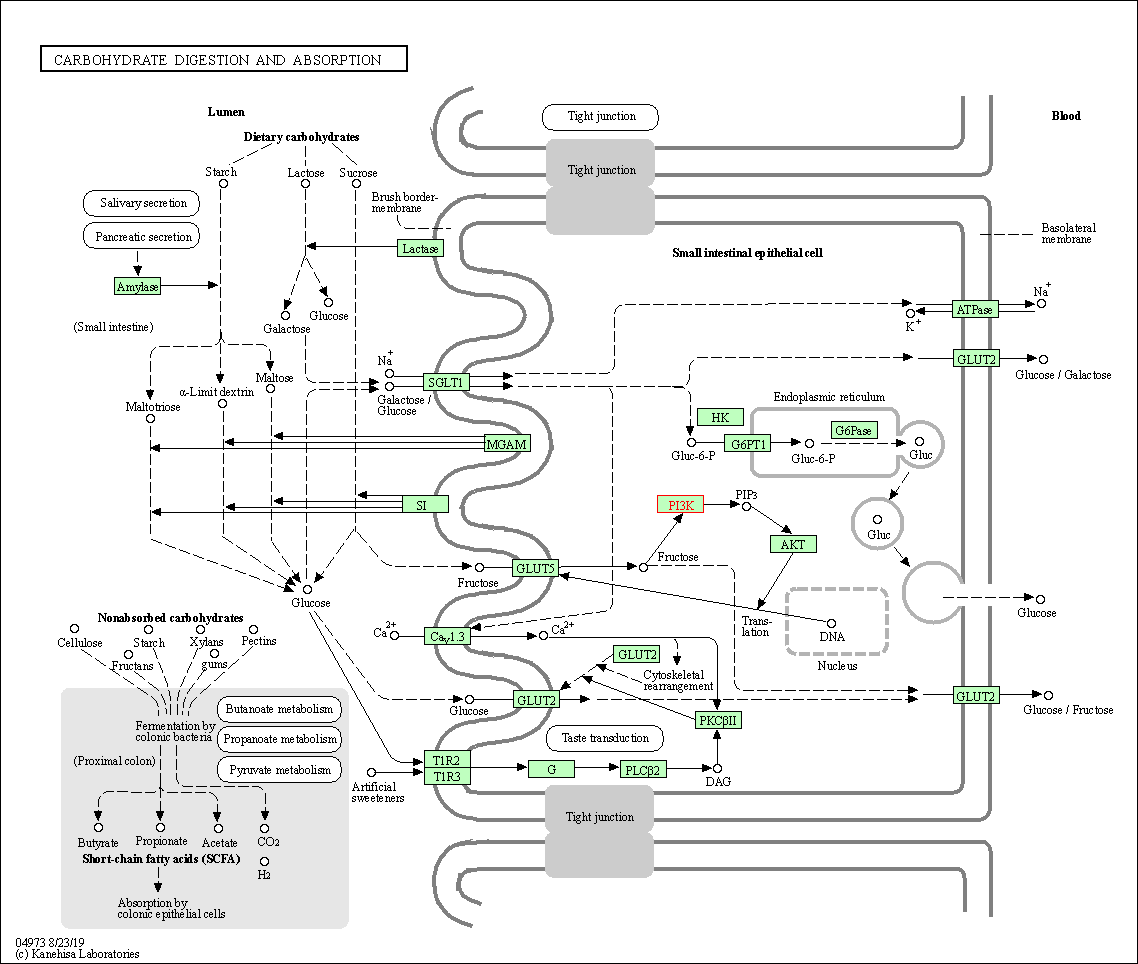
| KEGG Pathway | Pathway ID | Affiliated Target | Pathway Map |
|---|---|---|---|
| Inositol phosphate metabolism | hsa00562 | Affiliated Target |

|
| Class: Metabolism => Carbohydrate metabolism | Pathway Hierarchy | ||
| ErbB signaling pathway | hsa04012 | Affiliated Target |

|
| Class: Environmental Information Processing => Signal transduction | Pathway Hierarchy | ||
| Ras signaling pathway | hsa04014 | Affiliated Target |

|
| Class: Environmental Information Processing => Signal transduction | Pathway Hierarchy | ||
| Rap1 signaling pathway | hsa04015 | Affiliated Target |

|
| Class: Environmental Information Processing => Signal transduction | Pathway Hierarchy | ||
| cAMP signaling pathway | hsa04024 | Affiliated Target |

|
| Class: Environmental Information Processing => Signal transduction | Pathway Hierarchy | ||
| Chemokine signaling pathway | hsa04062 | Affiliated Target |

|
| Class: Organismal Systems => Immune system | Pathway Hierarchy | ||
| HIF-1 signaling pathway | hsa04066 | Affiliated Target |

|
| Class: Environmental Information Processing => Signal transduction | Pathway Hierarchy | ||
| FoxO signaling pathway | hsa04068 | Affiliated Target |

|
| Class: Environmental Information Processing => Signal transduction | Pathway Hierarchy | ||
| Phosphatidylinositol signaling system | hsa04070 | Affiliated Target |

|
| Class: Environmental Information Processing => Signal transduction | Pathway Hierarchy | ||
| Sphingolipid signaling pathway | hsa04071 | Affiliated Target |

|
| Class: Environmental Information Processing => Signal transduction | Pathway Hierarchy | ||
| Phospholipase D signaling pathway | hsa04072 | Affiliated Target |

|
| Class: Environmental Information Processing => Signal transduction | Pathway Hierarchy | ||
| Autophagy - animal | hsa04140 | Affiliated Target |

|
| Class: Cellular Processes => Transport and catabolism | Pathway Hierarchy | ||
| mTOR signaling pathway | hsa04150 | Affiliated Target |

|
| Class: Environmental Information Processing => Signal transduction | Pathway Hierarchy | ||
| PI3K-Akt signaling pathway | hsa04151 | Affiliated Target |

|
| Class: Environmental Information Processing => Signal transduction | Pathway Hierarchy | ||
| AMPK signaling pathway | hsa04152 | Affiliated Target |

|
| Class: Environmental Information Processing => Signal transduction | Pathway Hierarchy | ||
| Apoptosis | hsa04210 | Affiliated Target |

|
| Class: Cellular Processes => Cell growth and death | Pathway Hierarchy | ||
| Longevity regulating pathway | hsa04211 | Affiliated Target |

|
| Class: Organismal Systems => Aging | Pathway Hierarchy | ||
| Longevity regulating pathway - multiple species | hsa04213 | Affiliated Target |

|
| Class: Organismal Systems => Aging | Pathway Hierarchy | ||
| Cellular senescence | hsa04218 | Affiliated Target |

|
| Class: Cellular Processes => Cell growth and death | Pathway Hierarchy | ||
| Axon guidance | hsa04360 | Affiliated Target |

|
| Class: Organismal Systems => Development and regeneration | Pathway Hierarchy | ||
| VEGF signaling pathway | hsa04370 | Affiliated Target |

|
| Class: Environmental Information Processing => Signal transduction | Pathway Hierarchy | ||
| Osteoclast differentiation | hsa04380 | Affiliated Target |

|
| Class: Organismal Systems => Development and regeneration | Pathway Hierarchy | ||
| Focal adhesion | hsa04510 | Affiliated Target |

|
| Class: Cellular Processes => Cellular community - eukaryotes | Pathway Hierarchy | ||
| Signaling pathways regulating pluripotency of stem cells | hsa04550 | Affiliated Target |

|
| Class: Cellular Processes => Cellular community - eukaryotes | Pathway Hierarchy | ||
| Platelet activation | hsa04611 | Affiliated Target |

|
| Class: Organismal Systems => Immune system | Pathway Hierarchy | ||
| Neutrophil extracellular trap formation | hsa04613 | Affiliated Target |

|
| Class: Organismal Systems => Immune system | Pathway Hierarchy | ||
| Toll-like receptor signaling pathway | hsa04620 | Affiliated Target |

|
| Class: Organismal Systems => Immune system | Pathway Hierarchy | ||
| C-type lectin receptor signaling pathway | hsa04625 | Affiliated Target |

|
| Class: Organismal Systems => Immune system | Pathway Hierarchy | ||
| JAK-STAT signaling pathway | hsa04630 | Affiliated Target |

|
| Class: Environmental Information Processing => Signal transduction | Pathway Hierarchy | ||
| Natural killer cell mediated cytotoxicity | hsa04650 | Affiliated Target |

|
| Class: Organismal Systems => Immune system | Pathway Hierarchy | ||
| T cell receptor signaling pathway | hsa04660 | Affiliated Target |

|
| Class: Organismal Systems => Immune system | Pathway Hierarchy | ||
| B cell receptor signaling pathway | hsa04662 | Affiliated Target |

|
| Class: Organismal Systems => Immune system | Pathway Hierarchy | ||
| Fc epsilon RI signaling pathway | hsa04664 | Affiliated Target |

|
| Class: Organismal Systems => Immune system | Pathway Hierarchy | ||
| Fc gamma R-mediated phagocytosis | hsa04666 | Affiliated Target |

|
| Class: Organismal Systems => Immune system | Pathway Hierarchy | ||
| TNF signaling pathway | hsa04668 | Affiliated Target |

|
| Class: Environmental Information Processing => Signal transduction | Pathway Hierarchy | ||
| Leukocyte transendothelial migration | hsa04670 | Affiliated Target |

|
| Class: Organismal Systems => Immune system | Pathway Hierarchy | ||
| Neurotrophin signaling pathway | hsa04722 | Affiliated Target |

|
| Class: Organismal Systems => Nervous system | Pathway Hierarchy | ||
| Cholinergic synapse | hsa04725 | Affiliated Target |

|
| Class: Organismal Systems => Nervous system | Pathway Hierarchy | ||
| Inflammatory mediator regulation of TRP channels | hsa04750 | Affiliated Target |

|
| Class: Organismal Systems => Sensory system | Pathway Hierarchy | ||
| Regulation of actin cytoskeleton | hsa04810 | Affiliated Target |

|
| Class: Cellular Processes => Cell motility | Pathway Hierarchy | ||
| Insulin signaling pathway | hsa04910 | Affiliated Target |

|
| Class: Organismal Systems => Endocrine system | Pathway Hierarchy | ||
| Progesterone-mediated oocyte maturation | hsa04914 | Affiliated Target |

|
| Class: Organismal Systems => Endocrine system | Pathway Hierarchy | ||
| Estrogen signaling pathway | hsa04915 | Affiliated Target |

|
| Class: Organismal Systems => Endocrine system | Pathway Hierarchy | ||
| Prolactin signaling pathway | hsa04917 | Affiliated Target |

|
| Class: Organismal Systems => Endocrine system | Pathway Hierarchy | ||
| Thyroid hormone signaling pathway | hsa04919 | Affiliated Target |

|
| Class: Organismal Systems => Endocrine system | Pathway Hierarchy | ||
| Regulation of lipolysis in adipocytes | hsa04923 | Affiliated Target |

|
| Class: Organismal Systems => Endocrine system | Pathway Hierarchy | ||
| Relaxin signaling pathway | hsa04926 | Affiliated Target |

|
| Class: Organismal Systems => Endocrine system | Pathway Hierarchy | ||
| GnRH secretion | hsa04929 | Affiliated Target |

|
| Class: Organismal Systems => Endocrine system | Pathway Hierarchy | ||
| Growth hormone synthesis, secretion and action | hsa04935 | Affiliated Target |

|
| Class: Organismal Systems => Endocrine system | Pathway Hierarchy | ||
| Aldosterone-regulated sodium reabsorption | hsa04960 | Affiliated Target |

|
| Class: Organismal Systems => Excretory system | Pathway Hierarchy | ||
| Carbohydrate digestion and absorption | hsa04973 | Affiliated Target |

|
| Class: Organismal Systems => Digestive system | Pathway Hierarchy | ||
| Click to Show/Hide the Information of Affiliated Human Pathways | |||
| Degree | 13 | Degree centrality | 1.40E-03 | Betweenness centrality | 5.60E-04 |
|---|---|---|---|---|---|
| Closeness centrality | 2.27E-01 | Radiality | 1.40E+01 | Clustering coefficient | 1.15E-01 |
| Neighborhood connectivity | 2.52E+01 | Topological coefficient | 1.15E-01 | Eccentricity | 12 |
| Download | Click to Download the Full PPI Network of This Target | ||||
| Chemical Structure based Activity Landscape of Target | Top |
|---|---|
| Drug Property Profile of Target | Top | |
|---|---|---|
| (1) Molecular Weight (mw) based Drug Clustering | (2) Octanol/Water Partition Coefficient (xlogp) based Drug Clustering | |
|
|
||
| (3) Hydrogen Bond Donor Count (hbonddonor) based Drug Clustering | (4) Hydrogen Bond Acceptor Count (hbondacc) based Drug Clustering | |
|
|
||
| (5) Rotatable Bond Count (rotbonds) based Drug Clustering | (6) Topological Polar Surface Area (polararea) based Drug Clustering | |
|
|
||
| "RO5" indicates the cutoff set by lipinski's rule of five; "D123AB" colored in GREEN denotes the no violation of any cutoff in lipinski's rule of five; "D123AB" colored in PURPLE refers to the violation of only one cutoff in lipinski's rule of five; "D123AB" colored in BLACK represents the violation of more than one cutoffs in lipinski's rule of five | ||
| Co-Targets | Top | |||||
|---|---|---|---|---|---|---|
| Co-Targets | ||||||
| Target Poor or Non Binders | Top | |||||
|---|---|---|---|---|---|---|
| Target Poor or Non Binders | ||||||
| Target Regulators | Top | |||||
|---|---|---|---|---|---|---|
| Target-regulating microRNAs | ||||||
| Target Profiles in Patients | Top | |||||
|---|---|---|---|---|---|---|
| Target Expression Profile (TEP) |
||||||
| Target-Related Models and Studies | Top | |||||
|---|---|---|---|---|---|---|
| Target Validation | ||||||
| References | Top | |||||
|---|---|---|---|---|---|---|
| REF 1 | 2014 FDA drug approvals. Nat Rev Drug Discov. 2015 Feb;14(2):77-81. | |||||
| REF 2 | 2017 FDA drug approvals.Nat Rev Drug Discov. 2018 Feb;17(2):81-85. | |||||
| REF 3 | URL: http://www.guidetopharmacology.org Nucleic Acids Res. 2015 Oct 12. pii: gkv1037. The IUPHAR/BPS Guide to PHARMACOLOGY in 2016: towards curated quantitative interactions between 1300 protein targets and 6000 ligands. (Ligand id: 6741). | |||||
| REF 4 | 2018 FDA drug approvals.Nat Rev Drug Discov. 2019 Feb;18(2):85-89. | |||||
| REF 5 | FDA Approved Drug Products from FDA Official Website. 2023. Application Number: 217759. | |||||
| REF 6 | Drugs@FDA. U.S. Food and Drug Administration. U.S. Department of Health Human Services. 2021 | |||||
| REF 7 | URL: http://www.guidetopharmacology.org Nucleic Acids Res. 2015 Oct 12. pii: gkv1037. The IUPHAR/BPS Guide to PHARMACOLOGY in 2016: towards curated quantitative interactions between 1300 protein targets and 6000 ligands. (Ligand id: 7878). | |||||
| REF 8 | ClinicalTrials.gov (NCT01610284) Phase III Study of BKM120/Placebo With Fulvestrant in Postmenopausal Patients With Hormone Receptor Positive HER2-negative Locally Advanced or Metastatic Breast Cancer Refractory to Aromatase Inhibitor. U.S. National Institutes of Health. | |||||
| REF 9 | ClinicalTrials.gov (NCT04187508) A Phase IIa, Double-Blind, Randomized, Parallel Group, Placebo-Controlled Multi-Centre Study to Evaluate the Effect of AZD8154 Administered Via Nebulizer Once Daily on Allergen-Induced Inflammation in Subjects With Mild Allergic Asthma Challenged With an Inhaled Allergen. U.S.National Institutes of Health. | |||||
| REF 10 | Clinical pipeline report, company report or official report of the Pharmaceutical Research and Manufacturers of America (PhRMA) | |||||
| REF 11 | ClinicalTrials.gov (NCT04434937) Open-Label Study of Parsaclisib, in Japanese Participants With Relapsed or Refractory Follicular Lymphoma (CITADEL-213). U.S. National Institutes of Health. | |||||
| REF 12 | ClinicalTrials.gov (NCT04204057) Efficacy and Safety of Tenalisib (RP6530) in Patients With Relapsed/Refractory Chronic Lymphocytic Leukemia (CLL). U.S. National Institutes of Health. | |||||
| REF 13 | Trusted, scientifically sound profiles of drug programs, clinical trials, safety reports, and company deals, written by scientists. Springer. 2015. Adis Insight (drug id 800038471) | |||||
| REF 14 | ClinicalTrials.gov (NCT04495621) MEN1611 With Cetuximab in Metastatic Colorectal Cancer (C-PRECISE-01) (C-PRECISE-01). U.S. National Institutes of Health. | |||||
| REF 15 | ClinicalTrials.gov (NCT05269940) A Phase I/II Study Evaluating ZX-101A in Patients With Relapsed/Refractory Hematological Malignancies. U.S.National Institutes of Health. | |||||
| REF 16 | ClinicalTrials.gov (NCT01300026) AMG 319 Lymphoid Malignancy FIH. U.S. National Institutes of Health. | |||||
| REF 17 | ClinicalTrials.gov (NCT04282018) Brief Title: Study of BGB-10188 as Monotherapy, and in Combination With Zanubrutinib, and Tislelizumab. U.S. National Institutes of Health. | |||||
| REF 18 | Clinical pipeline report, company report or official report of Gilead. | |||||
| REF 19 | ClinicalTrials.gov (NCT02258555) Safety, Pharmacodynamics, Pharmacokinetics, and Efficacy of GS-9901 in Adults With Relapsed or Refractory Follicular Lymphoma, Marginal Zone Lymphoma, Chronic Lymphocytic Leukemia, or Small Lymphocytic Lymphoma. U.S. National Institutes of Health. | |||||
| REF 20 | ClinicalTrials.gov (NCT03045887) A Single-centre, Double-blind (Sponsor Open), Placebo Controlled Two Part Study to Evaluate the Safety, Tolerability and Pharmacokinetics of Single and Repeat Doses of GSK2292767 as a Dry Powder in Healthy Participants Who Smoke Cigarettes. U.S.National Institutes of Health. | |||||
| REF 21 | ClinicalTrials.gov (NCT03786926) Trial to Evaluate the Safety and Pharmacokinetics of HMPL-689 in Patients With Lymphomas. U.S. National Institutes of Health. | |||||
| REF 22 | Trusted, scientifically sound profiles of drug programs, clinical trials, safety reports, and company deals, written by scientists. Springer. 2015. Adis Insight (drug id 800031939) | |||||
| REF 23 | URL: http://www.guidetopharmacology.org Nucleic Acids Res. 2015 Oct 12. pii: gkv1037. The IUPHAR/BPS Guide to PHARMACOLOGY in 2016: towards curated quantitative interactions between 1300 protein targets and 6000 ligands. (Ligand id: 6060). | |||||
| REF 24 | Trusted, scientifically sound profiles of drug programs, clinical trials, safety reports, and company deals, written by scientists. Springer. 2015. Adis Insight (drug id 800007058) | |||||
| REF 25 | PI3K-delta and PI3K-gamma inhibition by IPI-145 abrogates immune responses and suppresses activity in autoimmune and inflammatory disease models. Chem Biol. 2013 Nov 21;20(11):1364-74. | |||||
| REF 26 | Effective "activated PI3K syndrome"-targeted therapy with the PI3K inhibitor leniolisib. Blood. 2017 Nov 23;130(21):2307-2316. | |||||
| REF 27 | Targeting the phosphoinositide 3-kinase pathway in cancer. Nat Rev Drug Discov. 2009 Aug;8(8):627-44. | |||||
| REF 28 | Discovery of AZD8154, a Dual PI3Kgamma-delta Inhibitor for the Treatment of Asthma. J Med Chem. 2021 Jun 24;64(12):8053-8075. | |||||
| REF 29 | Parsaclisib, a potent and highly selective PI3K inhibitor, in patients with relapsed or refractory B-cell malignancies. Blood. 2019 Apr 18;133(16):1742-1752. | |||||
| REF 30 | Clinical pipeline report, company report or official report of the Pharmaceutical Research and Manufacturers of America (PhRMA) | |||||
| REF 31 | INCB40093 is a selective PI3Kdelta inhibitor with potent antiproliferative activity against human B-cell tumors. | |||||
| REF 32 | The selective class I PI3K inhibitor CH5132799 targets human cancers harboring oncogenic PIK3CA mutations. Clin Cancer Res. 2011 May 15;17(10):3272-81. | |||||
| REF 33 | Clinical pipeline report, company report or official report of Zenshine Pharmaceuticals | |||||
| REF 34 | National Cancer Institute Drug Dictionary (drug id 696292). | |||||
| REF 35 | National Cancer Institute Drug Dictionary (drug id 741949). | |||||
| REF 36 | Clinical pipeline report, company report or official report of Gilead. | |||||
| REF 37 | Therapeutic target database update 2012: a resource for facilitating target-oriented drug discovery. Nucleic Acids Res. 2012 Jan;40(Database issue):D1128-36. | |||||
| REF 38 | Translation of Inhaled Drug Optimization Strategies into Clinical Pharmacokinetics and Pharmacodynamics Using GSK2292767A, a Novel Inhaled Phosphoinositide 3-Kinase delta Inhibitor. J Pharmacol Exp Ther. 2019 Jun;369(3):443-453. | |||||
| REF 39 | Clinical pipeline report, company report or official report of Hutchison MediPharma. | |||||
| REF 40 | Pyrrolo[2,3-d]pyrimidines active as Btk inhibitors.Expert Opin Ther Pat. 2017 Dec;27(12):1305-1318. | |||||
| REF 41 | Clinical pipeline report, company report or official report of Exelixis. | |||||
| REF 42 | Selective role of PI3K delta in neutrophil inflammatory responses. Biochem Biophys Res Commun. 2003 Sep 5;308(4):764-9. | |||||
| REF 43 | The PI3K/Akt pathway as a target in the treatment of hematologic malignancies. Anticancer Agents Med Chem. 2009 Jun;9(5):550-9. | |||||
| REF 44 | LY294002-geldanamycin heterodimers as selective inhibitors of the PI3K and PI3K-related family. Bioorg Med Chem Lett. 2001 Apr 9;11(7):909-13. | |||||
| REF 45 | ETP-46321, a dual p110alpha/ class IA phosphoinositide 3-kinase inhibitor modulates T lymphocyte activation and collagen-induced arthritis. Biochem Pharmacol. 2016 Apr 15;106:56-69. | |||||
| REF 46 | Structure-Based Design of Tricyclic NF-KappaB Inducing Kinase (NIK) Inhibitors That Have High Selectivity over Phosphoinositide-3-kinase (PI3K). J Med Chem. 2017 Jan 26;60(2):627-640. | |||||
| REF 47 | Discovery and optimization of heteroaryl piperazines as potent and selective PI3KDelta inhibitors. Bioorg Med Chem Lett. 2020 Jan 1;30(1):126715. | |||||
If You Find Any Error in Data or Bug in Web Service, Please Kindly Report It to Dr. Zhou and Dr. Zhang.

